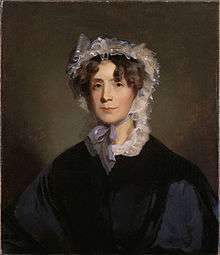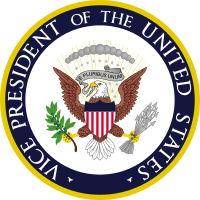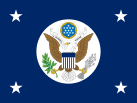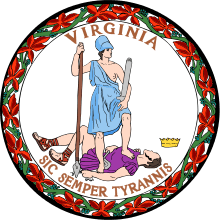Thomas Jefferson
| Thomas Jefferson | |
|---|---|
.jpg) | |
| 3rd President of the United States | |
|
In office March 4, 1801 – March 4, 1809 | |
| Vice President |
Aaron Burr (1801–1805) George Clinton (1805–1809) |
| Preceded by | John Adams |
| Succeeded by | James Madison |
| 2nd Vice President of the United States | |
|
In office March 4, 1797 – March 4, 1801 | |
| President | John Adams |
| Preceded by | John Adams |
| Succeeded by | Aaron Burr |
| 1st United States Secretary of State | |
|
In office March 22, 1790 – December 31, 1793 | |
| President | George Washington |
| Preceded by | John Jay (Foreign Affairs) |
| Succeeded by | Edmund Randolph |
| United States Minister to France | |
|
In office May 17, 1785 – September 26, 1789 | |
| Appointed by | Congress of the Confederation |
| Preceded by | Benjamin Franklin |
| Succeeded by | William Short |
| Delegate to the Congress of the Confederation from Virginia | |
|
In office November 3, 1783 – May 7, 1784 | |
| Preceded by | James Madison |
| Succeeded by | Richard H. Lee |
| 2nd Governor of Virginia | |
|
In office June 1, 1779 – June 3, 1781 | |
| Preceded by | Patrick Henry |
| Succeeded by | William Fleming |
| Delegate to the Second Continental Congress from Virginia | |
|
In office June 20, 1775 – September 26, 1776 | |
| Preceded by | George Washington |
| Succeeded by | John Harvie |
| Personal details | |
| Born |
April 13, 1743 Shadwell, Virginia, British America |
| Died |
July 4, 1826 (aged 83) Charlottesville, Virginia, United States |
| Political party | Democratic-Republican |
| Spouse(s) | Martha Wayles (m. 1772; d. 1782) |
| Children | 6, including Martha and Mary |
| Alma mater | College of William and Mary |
| Signature |
|
Thomas Jefferson (April 13 [O.S. April 2] 1743 – July 4, 1826) was an American Founding Father who was the principal author of the Declaration of Independence and later served as the third President of the United States from 1801 to 1809. Prior thereto, he was elected the second Vice President of the United States (1797–1801), serving under John Adams from 1797 to 1801. A proponent of democracy, republicanism, and individual rights motivating American colonists to break from Great Britain and form a new nation, he produced formative documents and decisions at both the state and national level.
Jefferson was primarily of English ancestry, born and educated in Virginia. He graduated from the College of William & Mary and briefly practiced law, at times defending slaves seeking their freedom. During the American Revolution, he represented Virginia in the Continental Congress that adopted the Declaration, drafted the law for religious freedom as a Virginia legislator, and served as a wartime governor (1779–1781). He became the United States Minister to France in May 1785, and subsequently the nation's first Secretary of State in 1790–1793 under President George Washington. Jefferson and James Madison organized the Democratic-Republican Party to oppose the Federalist Party during the formation of the First Party System. With Madison, he anonymously wrote the Kentucky and Virginia Resolutions in 1798–1799, which sought to embolden states' rights in opposition to the national government by nullifying the Alien and Sedition Acts.
As President, Jefferson pursued the nation's shipping and trade interests against Barbary pirates and aggressive British trade policies. He also organized the Louisiana Purchase, almost doubling the country's territory. As a result of peace negotiations with France, his administration reduced military forces. He was reelected in 1804. Jefferson's second term was beset with difficulties at home, including the trial of former Vice President Aaron Burr. American foreign trade was diminished when Jefferson implemented the Embargo Act of 1807, responding to British threats to U.S. shipping. In 1803, Jefferson began a controversial process of Indian tribe removal to the newly organized Louisiana Territory, and he signed the Act Prohibiting Importation of Slaves in 1807.
Jefferson mastered many disciplines, which ranged from surveying and mathematics to horticulture and mechanics. He was a proven architect in the classical tradition. Jefferson's keen interest in religion and philosophy earned him the presidency of the American Philosophical Society. He shunned organized religion, but was influenced by both Christianity and deism. He was well versed in linguistics and spoke several languages. He founded the University of Virginia after retiring from public office. He was a prolific letter writer and corresponded with many prominent and important people throughout his adult life. His only full-length book is Notes on the State of Virginia (1785), considered the most important American book published before 1800.
Jefferson owned several plantations which were worked by hundreds of slaves. Most historians now believe that, after the death of his wife in 1782, he had a relationship with his slave Sally Hemings and fathered at least one of her children. Historians have lauded Jefferson's public life, noting his primary authorship of the Declaration of Independence during the Revolutionary War, his advocacy of religious freedom and tolerance in Virginia, and the Louisiana Purchase while he was president. Various modern scholars are more critical of Jefferson's private life, pointing out the discrepancy between his ownership of slaves and his liberal political principles, for example. Presidential scholars consistently rank Jefferson among the greatest presidents.
Early life and career
Thomas Jefferson was born on April 13, 1743 (April 2, 1743 OS), at the family home in Shadwell in the Colony of Virginia, the third of ten children.[1] He was of English and possibly Welsh descent and was born a British subject.[2] His father Peter Jefferson was a planter and surveyor who died when Jefferson was fourteen; his mother was Jane Randolph.[lower-alpha 1] Peter Jefferson moved his family to Tuckahoe Plantation in 1745 upon the death of a friend who had named him guardian of his children. The Jeffersons returned to Shadwell in 1752, where Peter died in 1757; his estate was divided between his sons Thomas and Randolph.[4] Thomas inherited approximately 5,000 acres (2,000 ha; 7.8 sq mi) of land, including Monticello. He assumed full authority over his property at age 21.[5]
Education
.jpg)
Jefferson began his childhood education beside the Randolph children with tutors at Tuckahoe.[6] In 1752, he began attending a local school run by a Scottish Presbyterian minister. At age nine, he started studying Latin, Greek, and French; he learned to ride horses and began nature studies. He was taught from 1758 to 1760 by Reverend James Maury near Gordonsville, Virginia, where he studied history, science, and the classics while boarding with Maury's family.[7]
Jefferson entered the College of William & Mary in Williamsburg, Virginia, at age 16 and studied mathematics, metaphysics, and philosophy under Professor William Small. Small introduced him to the British Empiricists including John Locke, Francis Bacon, and Isaac Newton. Jefferson improved his French and Greek and his skill at the violin. He graduated two years after starting in 1762. He read the law under Professor George Wythe's tutelage to obtain his law license, while working as a law clerk in Wythe's office.[8] He also read a wide variety of English classics and political works.[9]
Jefferson treasured his books. In 1770, his Shadwell home was destroyed by fire, including a library of 200 volumes inherited from his father.[10] Nevertheless, he had replenished his library with 1,250 titles by 1773, and his collection grew to almost 6,500 volumes in 1814.[11] The British burned the Library of Congress that year, and he sold more than 6,000 books to the Library for $23,950. He had intended to pay off some of his large debt, but he resumed collecting for his personal library, writing to John Adams, "I cannot live without books".[12]
Lawyer and House of Burgesses
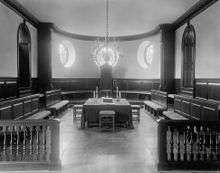
Jefferson was admitted to the Virginia bar in 1767 and then lived with his mother at Shadwell.[13] In addition to practicing law, Jefferson represented Albemarle County as a delegate in the Virginia House of Burgesses from 1769 until 1775.[14] He pursued reforms to slavery. He introduced legislation in 1769 allowing masters to take control over the emancipation of slaves, taking discretion away from the royal Governor and General Court. He persuaded his cousin Richard Bland to spearhead the legislation's passage, but reaction was strongly negative.[15]
Jefferson took seven cases for freedom-seeking slaves[16] and waived his fee for one client, who claimed that he should be freed before the statutory age of thirty-one required for emancipation in cases with inter-racial grandparents.[17] He invoked Natural Law to argue, "everyone comes into the world with a right to his own person and using it at his own will ... This is what is called personal liberty, and is given him by the author of nature, because it is necessary for his own sustenance." The judge cut him off and ruled against his client. As a consolation, Jefferson gave his client some money, conceivably used to aid his escape shortly thereafter.[17] He later incorporated this sentiment into the Declaration of Independence.[18] He also took on 68 cases for the General Court of Virginia in 1767, in addition to three notable cases: Howell v. Netherland (1770), Bolling v. Bolling (1771), and Blair v. Blair (1772).[19]
The British Parliament passed the Intolerable Acts in 1774, and Jefferson wrote a resolution calling for a "Day of Fasting and Prayer" in protest, as well as a boycott of all British goods. His resolution was later expanded into A Summary View of the Rights of British America, in which he argued that people have the right to govern themselves.[20]
Monticello, marriage and family
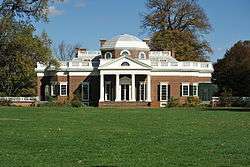
In 1768, Jefferson began constructing his primary residence Monticello (Italian for "Little Mountain") on a hilltop overlooking his 5,000-acre plantation.[lower-alpha 2] Construction was done mostly by local masons and carpenters, assisted by Jefferson's slaves.[22]
He moved into the South Pavilion in 1770. Turning Monticello into a neoclassical masterpiece in the Palladian style was his perennial project.[23]
On January 1, 1772, Jefferson married his third cousin Martha Wayles Skelton, the 23-year-old widow of Bathurst Skelton, and she moved into the South Pavilion.[24][25] She was a frequent hostess for Jefferson and managed the large household. Biographer Dumas Malone described the marriage as the happiest period of Jefferson's life.[26] Martha read widely, did fine needlework, and was a skilled pianist; Jefferson often accompanied her on the violin or cello.[27] During their ten years of marriage, Martha bore six children: Martha "Patsy" (1772–1836); Jane (1774–1775); a son who lived for only a few weeks in 1777; Mary Wayles "Polly" (1778–1804); Lucy Elizabeth (1780–1781); and another Lucy Elizabeth (1782–1785). Only Martha and Mary survived more than a few years.[28]
Martha's father John Wayles died in 1773, and the couple inherited 135 slaves, 11,000 acres (4,500 ha; 17 sq mi), and the estate's debts. The debts took Jefferson years to satisfy, contributing to his financial problems.[24]
Martha later suffered from ill health, including diabetes, and frequent childbirth further weakened her. Her mother had died young, and Martha lived with two stepmothers as a girl. A few months after the birth of her last child, she died on September 6, 1782 at the age of 33 with Jefferson at her bedside. Shortly before her death, Martha made Jefferson promise never to marry again, telling him that she could not bear to have another mother raise her children.[29] Jefferson was grief-stricken by her death, relentlessly pacing back and forth, nearly to the point of exhaustion. He emerged after three weeks, taking long rambling rides on secluded roads with his daughter Martha, by her description "a solitary witness to many a violent burst of grief".[28][30]
After working as Secretary of State (1790–93), he returned to Monticello and initiated a remodeling based on the architectural concepts which he had acquired in Europe. The work continued throughout most of his presidency, being finished in 1809.[31][32]
Political career 1775–1800
Declaration of Independence
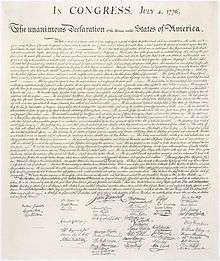
Jefferson was the primary author of the Declaration of Independence. At age 33, he was one of the youngest delegates to the Second Continental Congress beginning in 1775 at the outbreak of the American Revolutionary War, where a formal declaration of independence from Britain was overwhelmingly favored.[33] Jefferson chose his words for the Declaration in June 1775, shortly after the war had begun, where the idea of Independence from Britain had long since become popular among the colonies. He was also inspired by the Enlightenment ideals of the sanctity of the individual, as well as by the writings of Locke and Montesquieu.[34]
He sought out John Adams who had emerged as a leader of the Congress.[35] They became close friends and Adams supported Jefferson's appointment to the Committee of Five formed to draft a declaration of independence in furtherance of the Lee Resolution passed by the Congress, which declared the United Colonies independent. The committee initially thought that Adams should write the document, but Adams persuaded the committee to choose Jefferson.[lower-alpha 3]
Jefferson consulted with other committee members over the next seventeen days, and drew on his own proposed draft of the Virginia Constitution, George Mason's draft of the Virginia Declaration of Rights, and other sources.[37] The other committee members made some changes, and a final draft was presented to the Congress on June 28, 1776.[38]
The declaration was introduced on Friday, June 28, and congress began debate over its contents on Monday, July 1,[38] resulting in the omission of a fourth of the text, including a passage critical of King George III and the slave trade.[39] Jefferson resented the changes, but he did not speak publicly about the revisions.[lower-alpha 4] On July 4, 1776, the Congress ratified the Declaration, and delegates signed it on August 2; in doing so, they were committing an act of treason against the Crown.[41] Jefferson's preamble is regarded as an enduring statement of human rights, and the phrase "all men are created equal" has been called "one of the best-known sentences in the English language" containing "the most potent and consequential words in American history".[39][42]
Virginia state legislator and governor
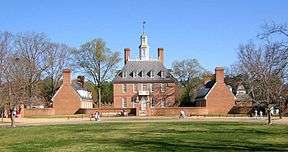
At the start of the Revolution, Jefferson was a Colonel and was named commander of the Albemarle County Militia on September 26, 1775.[43] He was then elected to the Virginia House of Delegates for Albemarle County in September 1776, when finalizing a state constitution was a priority.[44][45] For nearly three years, he assisted with the constitution and was especially proud of his Bill for Establishing Religious Freedom, which forbade state support of religious institutions or enforcement of religious doctrine.[46] The bill failed to pass, as did his legislation to disestablish the Anglican church, but both were later revived by James Madison.[47]
In 1778, Jefferson was given the task of studying and revising the state's laws. He drafted 126 bills in three years, including laws to establish fee simple tenure in land and to streamline the judicial system. Jefferson's proposed statutes abolished primogeniture and provided for general education, which he considered the basis of "republican government".[44]
Jefferson was elected governor for one-year terms in 1779 and 1780.[48] He transferred the state capital from Williamsburg to Richmond, and introduced measures for public education, religious freedom, and revision of inheritance laws.[49]
During General Benedict Arnold's 1781 invasion of Virginia, Jefferson escaped Richmond just ahead of the British forces, and the city was burned to the ground.[50][51] General Charles Cornwallis that spring dispatched a cavalry force led by Banastre Tarleton to capture Jefferson and members of the Assembly at Monticello, but Jack Jouett of the Virginia militia thwarted the British plan. Jefferson escaped to Poplar Forest, his plantation to the west.[52] When the General Assembly reconvened in June 1781, it conducted an inquiry into Jefferson's actions which eventually concluded that Jefferson had acted with honor—but he was not re-elected.[53]
In April of the same year, his daughter Lucy died at age one. A second daughter of that name was born the following year, but she died at age three.[54]
Notes on the State of Virginia
Jefferson received a letter of inquiry in 1780 about the geography, history, and government of Virginia from French diplomat François Barbé-Marbois, who was gathering data on the United States. Jefferson included his written responses in a book, Notes on the State of Virginia (1785).[55] He compiled the book over five years, including reviews of scientific knowledge, Virginia's history, politics, laws, culture, and geography.[56] The book explores what constitutes a good society, using Virginia as an exemplar. Jefferson included extensive data about the state's natural resources and economy, and wrote at length about slavery, miscegenation, and his belief that blacks and whites could not live together as free people in one society because of justified resentments of the enslaved.[57] He also wrote of his views on the American Indian and considered them as equals in body and mind to European settlers.[58][59]
Notes was first published in 1785 in French and appeared in English in 1787.[60] Biographer George Tucker considered the work "surprising in the extent of the information which a single individual had been thus able to acquire, as to the physical features of the state",[61] and Merrill D. Peterson described it as an accomplishment for which all Americans should be grateful.[62]
Member of Congress

The United States formed a Congress of the Confederation following victory in the Revolutionary War and a peace treaty with Great Britain in 1783, to which Jefferson was appointed as a Virginia delegate. He was a member of the committee setting foreign exchange rates and recommended an American currency based on the decimal system which was adopted.[63] He advised formation of the Committee of the States to fill the power vacuum when Congress was in recess.[64] The Committee met when Congress adjourned, but disagreements rendered it dysfunctional.[65]
In the Congress's 1783–84 session, Jefferson acted as chairman of committees to establish a viable system of government for the new Republic and to propose a policy for the settlement of the western territories. Jefferson was the principal author of the Land Ordinance of 1784, whereby Virginia ceded to the national government the vast area that it claimed northwest of the Ohio River. He insisted that this territory should not be used as colonial territory by any of the thirteen states, but that it should be divided into sections which could become states. He plotted borders for nine new states in their initial stages and wrote an ordinance banning slavery in all the nation's territories. Congress made extensive revisions, including rejection of the ban on slavery.[66][67] The provisions banning slavery were known later as the "Jefferson Proviso;" they were modified and implemented three years later in the Northwest Ordinance of 1787 and became the law for the entire Northwest.[66]
Minister to France

Jefferson was sent by the Congress of the Confederation[lower-alpha 5] to join Benjamin Franklin and John Adams as ministers in Europe for negotiation of trade agreements with England, Spain, and France. Some believed that the recently widowed Jefferson was depressed and that the assignment would distract him from his wife's death.[68] With his young daughter Patsy and two servants, he departed in July 1784, arriving in Paris the next month.[69][70] French foreign minister Count de Vergennes commented, "You replace Monsieur Franklin, I hear." Jefferson replied, "I succeed. No man can replace him."[71] Franklin resigned as minister in March 1785 and departed in July.[72]
Jefferson had Patsy educated at the Pentemont Abbey. In 1786, he met and fell in love with Maria Cosway, an accomplished—and married—Italian-English musician of 27. They saw each other frequently over a period of six weeks. She returned to Great Britain, but they maintained a lifelong correspondence.[73]
Jefferson sent for his youngest surviving child, nine-year-old Polly, in June 1787. He brought some of his slaves, including James Hemings whom he had trained in French cuisine and his younger sister Sally Hemings.[74] She lived in the Jefferson household in Paris for about two years. According to her son Madison Hemings, Sally and Jefferson began a sexual relationship in Paris and she became pregnant.[75] She was about 16 at the time. She agreed to return to the United States as his concubine after he promised to free her children when they came of age.[75]
While in France, he became a regular companion of the Marquis de Lafayette, a French hero of the American Revolutionary War, and Jefferson used his influence to procure trade agreements with France.[76][77] As the French Revolution began, Jefferson allowed his Paris residence, the Hôtel de Langeac, to be used for meetings by Lafayette and other republicans. He was in Paris during the storming of the Bastille and consulted with Lafayette while the latter drafted the Declaration of the Rights of Man and of the Citizen.[78] Jefferson often found his mail opened by postmasters, so he invented his own enciphering device, the "Wheel Cipher"; he wrote important communications in code for the rest of his career.[79][lower-alpha 6] Jefferson left Paris in September 1789, intending to return soon; however, President George Washington appointed him the country's first Secretary of State, forcing him to remain.[80] Jefferson remained a firm supporter of the French Revolution, while opposing its more violent elements.[81]
Secretary of State
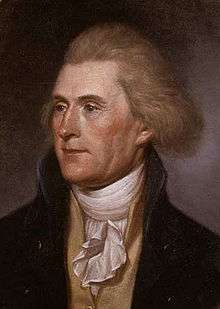
Soon after returning from France, Jefferson accepted Washington's invitation to serve as Secretary of State.[82] Jefferson had initially expected to return to France, but Washington insisted that he be on his new Cabinet.[83] Pressing issues at this time were the national debt and the permanent location of the capital. Jefferson opposed a national debt, preferring that each state retire its own, in contrast to Secretary of the Treasury Alexander Hamilton, who desired consolidation of various states' debts by the federal government.[84] Hamilton also had bold plans to establish the national credit and a national bank, but Jefferson strenuously opposed this and attempted to undermine his agenda, which nearly led Washington to dismiss him from his cabinet. Jefferson later left the cabinet voluntarily; Washington never forgave him, and never spoke to him again.[85]
The second major issue was the capital's permanent location. Hamilton favored a capital close to the major commercial centers of the Northeast, while Washington, Jefferson, and other agrarians wanted it located to the south.[86] After lengthy deadlock, the Compromise of 1790 was struck, permanently locating the capital on the Potomac River, and the federal government assumed the war debts of all thirteen states.[86]
In the Spring of 1791, Jefferson and Congressman James Madison took a vacation to Vermont. Jefferson had been suffering from migraines and he was tired of Hamilton in-fighting.[83] In May 1792, Jefferson was alarmed at the political rivalries taking shape; he wrote to Washington, urging him to run for re-election that year as a unifying influence.[87] He urged the president to rally the citizenry to a party that would defend democracy against the corrupting influence of banks and monied interests, as espoused by the Federalists. Historians recognize this letter as the earliest delineation of Democratic-Republican Party principles.[88] Jefferson, Madison, and other Democratic-Republican organizers favored states' rights and local control and opposed federal concentration of power, whereas Hamilton sought more power for the federal government.[89]
Jefferson supported France against Britain when the two nations fought in 1793, though his arguments in the Cabinet were undercut by French Revolutionary envoy Edmond-Charles Genêt's open scorn for President Washington.[90] In his discussions with British Minister George Hammond, Jefferson tried unsuccessfully to persuade the British to acknowledge their violation of the Treaty of Paris, to vacate their posts in the Northwest, and to compensate the U.S. for slaves whom the British had freed at the end of the war. Seeking a return to private life, Jefferson resigned the cabinet position in December 1793, perhaps to bolster his political influence from outside the administration.[91]
After the Washington administration negotiated the Jay Treaty with Great Britain (1794), Jefferson saw a cause around which to rally his party and organized a national opposition from Monticello.[92] The treaty, designed by Hamilton, aimed to reduce tensions and increase trade. Jefferson warned that it would increase British influence and subvert republicanism, calling it "the boldest act [Hamilton and Jay] ever ventured on to undermine the government".[93] The Treaty passed, but it expired in 1805 during Jefferson's administration and was not renewed. Jefferson continued his pro-French stance; during the violence of the Reign of Terror, he declined to disavow the revolution: "To back away from France would be to undermine the cause of republicanism in America."[94]
Election of 1796 and Vice Presidency
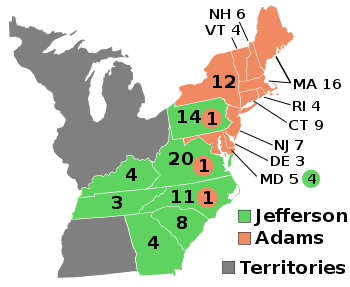
In the presidential campaign of 1796, Jefferson lost the electoral college vote to Federalist John Adams by 71–68 and was elected vice president because of a mistake in voting for Adams' running mate. As presiding officer of the Senate, he assumed a more passive role than his predecessor John Adams. He allowed the Senate to freely conduct debates and confined his participation to procedural issues, which he called an "honorable and easy" role.[95] Jefferson had previously studied parliamentary law and procedure for forty years, making him unusually well qualified to serve as presiding officer. In 1800, he published his assembled notes on Senate procedure as A Manual of Parliamentary Practice.[96]
Jefferson held four confidential talks with French consul Joseph Létombe in the spring of 1797 where he attacked Adams, predicting that his rival would serve only one term. He also encouraged France to invade England, and advised Létombe to stall any American envoys sent to Paris by instructing him to "listen to them and then drag out the negotiations at length and mollify them by the urbanity of the proceedings."[97] This toughened the tone that the French government adopted toward the Adams administration. After Adams' initial peace envoys were rebuffed, Jefferson and his supporters lobbied for the release of papers related to the incident, called the XYZ Affair after the letters used to disguise the identities of the French officials involved.[98] However, the tactic backfired when it was revealed that French officials had demanded bribes, rallying public support against France. The U.S. began an undeclared naval war with France known as the Quasi-War.[99]
During the Adams presidency, the Federalists rebuilt the military, levied new taxes, and enacted the Alien and Sedition Acts. Jefferson believed that these laws were intended to suppress Democratic-Republicans, rather than prosecute enemy aliens, and considered them unconstitutional.[100] To rally opposition, he and James Madison anonymously wrote the Kentucky and Virginia Resolutions, declaring that the federal government had no right to exercise powers not specifically delegated to it by the states.[101] The resolutions followed the "interposition" approach of Madison, in which states may shield their citizens from federal laws that they deem unconstitutional. Jefferson advocated nullification, allowing states to invalidate federal laws altogether.[102][lower-alpha 7] Jefferson warned that, "unless arrested at the threshold", the Alien and Sedition Acts would "necessarily drive these states into revolution and blood".[104]
Historian Ron Chernow claims that "the theoretical damage of the Kentucky and Virginia Resolutions was deep and lasting, and was a recipe for disunion", contributing to the American Civil War as well as later events.[105] Washington was so appalled by the resolutions that he told Patrick Henry that, if "systematically and pertinaciously pursued", the resolutions would "dissolve the union or produce coercion."[106]
Jefferson and Madison moved to Philadelphia and founded the National Gazette in 1791, along with poet and writer Phillip Freneau, in an effort to counter Hamilton's Federalist policies, which Hamilton was promoting through the influential Federalist newspaper the Gazette of the United States. The National Gazette made particular criticism of the policies promoted by Alexander Hamilton, often through anonymous essays signed by the pen name Brutus at Jefferson's urging, which were actually written by Madison.[107]
Jefferson had always admired Washington's leadership skills but felt that his Federalist party was leading the country in the wrong direction. Jefferson thought it wise not to attend his funeral in 1799 because of acute differences with Washington while serving as Secretary of State, and remained at Monticello.[108]
Election of 1800
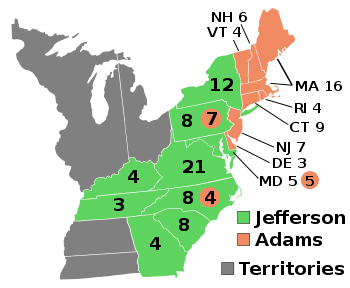
In the 1800 presidential election, Jefferson contended once more against Federalist John Adams. Adams' campaign was weakened by unpopular taxes and vicious Federalist infighting over his actions in the Quasi-War.[109] Republicans pointed to the Alien and Sedition Acts and accused the Federalists of being secret monarchists, while Federalists charged that Jefferson was a godless libertine in thrall to the French.[110] Historian Joyce Appleby said the election was "one of the most acrimonious in the annals of American history".[111]
Republicans ultimately won more electoral college votes, but Jefferson and his vice-presidential candidate Aaron Burr unexpectedly received an equal total. Due to the tie, the election was decided by the Federalist-dominated House of Representatives.[112][lower-alpha 8] Hamilton lobbied Federalist representatives on Jefferson's behalf, believing him a lesser political evil than Burr. On February 17, 1801, after thirty-six ballots, the House elected Jefferson president and Burr vice president.[113]
The win was marked by Republican celebrations throughout the country.[114] Some of Jefferson's opponents argued that he owed his victory over Adams to the South's inflated number of electors, due to counting slaves as partial population under the Three-Fifths Compromise."[115] Others alleged that Jefferson secured James Asheton Bayard's tie-breaking electoral vote by guaranteeing the retention of various Federalist posts in the government.[113] Jefferson disputed the allegation, and the historical record is inconclusive.[116]
The transition proceeded smoothly, marking a watershed in American history. As historian Gordon S. Wood writes, "it was one of the first popular elections in modern history that resulted in the peaceful transfer of power from one 'party' to another."[113]
Presidency (1801–1809)
| The Jefferson Cabinet | ||
|---|---|---|
| Office | Name | Term |
| President | Thomas Jefferson | 1801–1809 |
| Vice President | Aaron Burr | 1801–1805 |
| George Clinton | 1805–1809 | |
| Secretary of State | James Madison | 1801–1809 |
| Secretary of Treasury | Samuel Dexter | 1801 |
| Albert Gallatin | 1801–1809 | |
| Secretary of War | Henry Dearborn | 1801–1809 |
| Attorney General | Levi Lincoln Sr. | 1801–1804 |
| John Breckinridge | 1805–1806 | |
| Caesar A. Rodney | 1807–1809 | |
| Secretary of the Navy | Benjamin Stoddert | 1801 |
| Robert Smith | 1801–1809 | |
Jefferson was sworn in by Chief Justice John Marshall at the new Capitol in Washington, D.C. on March 4, 1801. In contrast to his predecessors, Jefferson exhibited a dislike of formal etiquette; he arrived alone on horseback without escort, dressed plainly[117] and, after dismounting, retired his own horse to the nearby stable.[118] His inaugural address struck a note of reconciliation, declaring, "We have been called by different names brethren of the same principle. We are all Republicans, we are all Federalists."[119] Ideologically, Jefferson stressed "equal and exact justice to all men", minority rights, and freedom of speech, religion, and press.[120] He said that a free and democratic government was "the strongest government on earth."[120] He nominated moderate Republicans to his cabinet: James Madison as Secretary of State, Henry Dearborn as Secretary of War, Levi Lincoln as Attorney General, and Robert Smith as Secretary of the Navy.[121]
Upon assuming office, he first confronted an $83 million national debt.[122] He began dismantling Hamilton's Federalist fiscal system with help from Secretary of Treasury Albert Gallatin.[121] Jefferson's administration eliminated the whiskey excise and other taxes after closing "unnecessary offices" and cutting "useless establishments and expenses".[123][124] They attempted to disassemble the national bank and its effect of increasing national debt, but were dissuaded by Gallatin.[125] Jefferson shrank the Navy, deeming it unnecessary in peacetime.[126] Instead, he incorporated a fleet of inexpensive gunboats used only for defense with the idea that they would not provoke foreign hostilities.[123] After two terms, he had lowered the national debt from $83 million to $57 million.[122]
Jefferson pardoned several of those imprisoned under the Alien and Sedition Acts.[127] Congressional Republicans repealed the Judiciary Act of 1801, which removed nearly all of Adams' "midnight judges" from office. A subsequent appointment battle led to the Supreme Court's landmark decision in Marbury v. Madison, asserting judicial review over executive branch actions.[128] Jefferson appointed three Supreme Court justices: William Johnson (1804), Henry Brockholst Livingston (1807), and Thomas Todd (1807).[129]
Jefferson strongly felt the need for a national military university, producing an officer engineering corps for a national defense based on the advancement of the sciences, rather than having to rely on foreign sources for top grade engineers with questionable loyalty.[130] He signed the Military Peace Establishment Act on March 16, 1802, thus founding the United States Military Academy at West Point. The Act documented in 29 sections a new set of laws and limits for the military. Jefferson was also hoping to bring reform to the Executive branch, replacing Federalists and active opponents throughout the officer corps to promote Republican values.[131]
First Barbary War
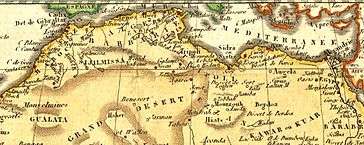
American merchant ships had been protected from Barbary Coast pirates by the Royal Navy when the states were British colonies.[132] After independence, however, pirates often captured U.S. merchant ships, pillaged cargoes, and enslaved or held crew members for ransom. Jefferson had opposed paying tribute to the Barbary States since 1785.[133] In March 1786, he and John Adams went to London to negotiate with Tripoli's envoy, ambassador Sidi Haji Abdrahaman (or Sidi Haji Abdul Rahman Adja).[134] In 1801, he authorized a U.S. Navy fleet under Commodore Richard Dale to make a show of force in the Mediterranean, the first American naval squadron to cross the Atlantic.[135] Following the fleet's first engagement, he successfully asked Congress for a declaration of war.[135] The subsequent "First Barbary War" was the first foreign war fought by the U.S.[136]
Pasha of Tripoli Yusuf Karamanli captured the USS Philadelphia, so Jefferson authorized William Eaton, the U.S. Consul to Tunis, to lead a force to restore the pasha's older brother to the throne.[137] The American navy forced Tunis and Algiers into breaking their alliance with Tripoli. Jefferson ordered five separate naval bombardments of Tripoli, leading the pasha to sign a treaty that restored peace in the Mediterranean.[138] This victory proved only temporary, but according to Wood, "many Americans celebrated it as a vindication of their policy of spreading free trade around the world and as a great victory for liberty over tyranny."[139]
Louisiana Purchase
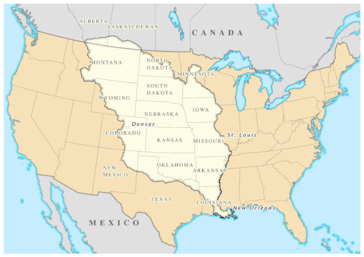
Spain ceded ownership of the Louisiana territory in 1800 to the more predominant France. Jefferson was greatly concerned that Napoleon's broad interests in the vast territory would threaten the security of the continent and Mississippi River shipping. He wrote that the cession "works most sorely on the U.S. It completely reverses all the political relations of the U.S." [140] In 1802, he instructed James Monroe and Robert R. Livingston to negotiate with Napoleon to purchase New Orleans and adjacent coastal areas from France.[141] In early 1803, Jefferson offered Napoleon nearly $10 million for 40,000 square miles (100,000 square kilometres) of tropical territory.[142]
Napoleon realized that French military control was impractical over such a vast remote territory, and he was in dire need of funds for his wars on the home front. In early April 1803, he unexpectedly made negotiators a counter-offer to sell 827,987 square miles (2,144,480 square kilometres) of French territory for $15 million, doubling the size of the United States.[142] U.S. negotiators seized this unique opportunity and accepted the offer and signed the treaty on April 30, 1803.[122] Word of the unexpected purchase didn't reach Jefferson until July 3, 1803.[122] He unknowingly acquired the most fertile tract of land of its size on Earth, making the new country self-sufficient in food and other resources. The sale also significantly curtailed British and French imperial ambitions in North America, removing obstacles to U.S. westward expansion.[143]
Most thought that this was an exceptional opportunity, despite Republican reservations about the Constitutional authority of the federal government to acquire land.[144] Jefferson initially thought that a Constitutional amendment was necessary to purchase and govern the new territory; but he later changed his mind, fearing that this would give cause to oppose the purchase, and he therefore urged a speedy debate and ratification.[145] On October 20, 1803, the Senate ratified the purchase treaty by a vote of 24–7.[146]
After the purchase, Jefferson preserved the region's Spanish legal code and instituted a gradual approach for integrating settlers into American democracy. He believed that a period of federal rule would be necessary while Louisianians adjusted to their new nation.[147][lower-alpha 9] Historians have differed in their assessments regarding the constitutional implications of the sale,[149] but they typically hail the Louisiana acquisition as a major accomplishment. Frederick Jackson Turner called the purchase the most formative event in American history.[143]
Lewis and Clark expedition

October, 1805
Jefferson anticipated further westward settlements due to the Louisiana Purchase and arranged for the exploration and mapping of the uncharted territory. He sought to establish a U.S. claim ahead of competing European interests and to find the rumored Northwest Passage.[150] Jefferson and others were influenced by exploration accounts of Le Page du Pratz in Louisiana (1763) and Captain James Cook in the Pacific (1784),[151] and they persuaded Congress in 1804 to fund an expedition to explore and map the newly acquired territory to the Pacific Ocean.[152]
Jefferson appointed Meriwether Lewis and William Clark to be leaders of the Corps of Discovery (1803–1806).[153] In the months leading up to the expedition, Jefferson tutored Lewis in the sciences of mapping, botany, natural history, mineralogy, and astronomy and navigation, giving him unlimited access to his library at Monticello, which included the largest collection of books in the world on the subject of the geography and natural history of the North American continent, along with an impressive collection of maps.[154]
The expedition lasted from May, 1804 to September, 1806 (see Timeline) and obtained a wealth of scientific and geographic knowledge, including knowledge of many Indian tribes.[155]
- Other expeditions
In addition to the Corps of Discovery, Jefferson organized three other western expeditions: the William Dunbar and George Hunter expedition on the Ouachita River (1804–1805), the Thomas Freeman and Peter Custis expedition (1806) on the Red River, and the Zebulon Pike expedition (1806–1807) into the Rocky Mountains and the Southwest. All three produced valuable information about the American frontier.[156]
American Indian policies
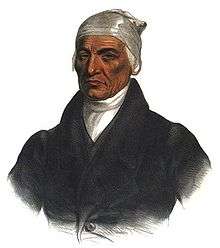
Jefferson's experiences with the American Indian began during his boyhood in Virginia and extended through his political career and into his retirement. He refuted the contemporary notion that Indians were an inferior people and maintained that they were equal in body and mind to people of European descent.[157]
As governor of Virginia during the Revolutionary War, Jefferson recommended moving the Cherokee and Shawnee tribes, who had allied with the British, to west of the Mississippi River. But when he took office as President, he quickly took measures to avert another major conflict, as American and Indian societies were in collision and the British were inciting Indian tribes from Canada.[158][159] In Georgia, he stipulated that the state would release its legal claims for lands to its west in exchange for military support in expelling the Cherokee from Georgia. This facilitated his policy of western expansion, to "advance compactly as we multiply".[160]
In keeping with his Enlightenment thinking, President Jefferson adopted an assimilation policy towards American Indians known as his "civilization program" which included securing peaceful U.S. – Indian treaty alliances and encouraging agriculture. Jefferson advocated that Indian tribes should make federal purchases by credit holding their lands as collateral for repayment. Various tribes accepted Jefferson's policies, including the Shawnees led by Black Hoof, the Creek, and the Cherokees. However, some Shawnees broke off from Black Hoof, led by Tecumseh, and opposed Jefferson's assimilation policies.[161]
Historian Bernard Sheehan argues that Jefferson believed that assimilation was best for American Indians; second best was removal to the west. He felt that the worst outcome of the cultural and resources conflict between American citizens and American Indians would be their attacking the whites.[159] Jefferson told Secretary of War General Henry Dearborn (Indian affairs were then under the War Department), "If we are constrained to lift the hatchet against any tribe, we will never lay it down until that tribe is exterminated or driven beyond the Mississippi." [162] Miller agrees that Jefferson believed that Indians should assimilate to American customs and agriculture. Historians such as Peter S. Onuf and Merrill D. Peterson argue that Jefferson's actual Indian policies did little to promote assimilation and were a pretext to seize lands.[163]
Re-election in 1804 and second term
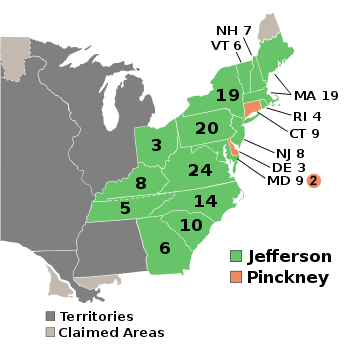
Jefferson's successful first term occasioned his re-nomination for president by the Republican party, with George Clinton replacing Burr as his running mate.[164] The Federalist party ran Charles Cotesworth Pinckney of South Carolina, John Adams' vice-presidential candidate in the 1800 election. The Jefferson-Clinton ticket won overwhelmingly in the electoral college vote, by 162 to 14, promoting their achievement of a strong economy, lower taxes, and the Louisiana Purchase.[164]
In March 1806, a split developed in the Republican party, led by fellow Virginian and former Republican ally John Randolph who viciously accused President Jefferson on the floor of the House of moving too far in the Federalist direction. In so doing, Randolph permanently set himself apart politically from Jefferson. Jefferson and Madison had backed resolutions to limit or ban British imports in retaliation for British actions against American shipping. Also, in 1808, Jefferson was the first president to propose a broad Federal plan to build roads and canals across several states, asking for $20 million, further alarming Randolph and believers of limited government.[165]
Jefferson's popularity further suffered in his second term due to his response to wars in Europe. Positive relations with Great Britain had diminished, due partly to the antipathy between Jefferson and British diplomat Anthony Merry. After Napoleon's decisive victory at the Battle of Austerlitz in 1805, Napoleon became more aggressive in his negotiations over trading rights, which American efforts failed to counter. Jefferson then led the enactment of the Embargo Act of 1807, directed at both France and Great Britain. This triggered economic chaos in the U.S. and was strongly criticized at the time, resulting in Jefferson having to abandon the policy a year later.[166]
During the revolutionary era, the states abolished the international slave trade, but South Carolina reopened it. In his annual message of December 1806, Jefferson denounced the "violations of human rights" attending the international slave trade, calling on the newly elected Congress to criminalize it immediately. In 1807, Congress passed the Act Prohibiting Importation of Slaves, which Jefferson signed.[167][168] The act established severe punishment against the international slave trade, although it did not address the issue domestically.[169]
In the wake of the Louisiana Purchase, Jefferson sought to annex Florida from Spain, as brokered by Napoleon.[170] Congress agreed to the President's request to secretly appropriate purchase money in the "$2,000,000 Bill".[170] The Congressional funding drew criticism from Randolph, who believed that the money would wind up in the coffers of Napoleon. The bill was signed into law; however, negotiations for the project failed. Jefferson lost clout among fellow Republicans, and his use of unofficial Congressional channels was sharply criticized.[170] In Haiti, Jefferson's neutrality had allowed arms to enable the slave independence movement during its Revolution, and blocked attempts to assist Napoleon, who was defeated there in 1803.[171] But he refused official recognition of the country during his second term, in deference to southern complaints about the racial violence against slave-holders; it was eventually extended to Haiti in 1862.[172] Domestically, Jefferson's grandson James Madison Randolph became the first child born in the White House in 1806.[173]
Burr conspiracy and trial
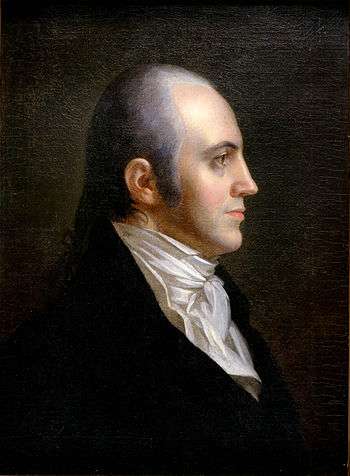
Vanderlyn 1802
Following the 1801 electoral deadlock, Jefferson's relationship rapidly eroded with his Vice President, former New York Senator Aaron Burr. Jefferson suspected Burr of seeking the presidency for himself, while Burr was angered by Jefferson's refusal to appoint some of his supporters to federal office. Burr was dropped from the Republican ticket in 1804.
The same year, Burr was soundly defeated in his bid to be elected New York governor. During the campaign, Alexander Hamilton publicly made callous remarks regarding Burr's moral character.[174] Subsequently, Burr challenged Hamilton to a duel, mortally wounding and killing Hamilton on July 11, 1804. Burr was indicted for Hamilton's murder in New York and New Jersey, causing him to flee to Georgia, although he remained President of the Senate during Supreme Court Justice Samuel Chase's impeachment trial.[175] Both indictments quietly died and Burr was not prosecuted.[176] Also during the election, certain New England separatists approached Burr, desiring a New England federation and intimating that he would be their leader.[177] However, nothing came of the plot, since Burr had lost the election and his reputation was ruined after killing Hamilton.[177] In August 1804, Burr contacted British Minister Anthony Merry offering to capture U.S. western territory in return for money and British ships.[178]
After leaving office in April 1805, Burr traveled west and conspired with Louisiana Territory governor James Wilkinson, beginning a large-scale recruitment for a military expedition.[179] Other plotters included Ohio Senator John Smith and an Irishman named Harmon Blennerhassett.[179] Burr discussed a number of plots—seizing control of Mexico or Spanish Florida, or forming a secessionist state in New Orleans or the Western U.S. Historians remain unclear as to his true goal.[180][lower-alpha 10]
In the fall of 1806, Burr launched a military flotilla carrying about 60 men down the Ohio River. Wilkinson renounced the plot, apparently from self-interested motives; he reported Burr's expedition to Jefferson, who immediately ordered Burr's arrest.[179][182][183] On February 13, 1807, Burr was captured in Louisiana's Bayou Pierre wilderness and sent to Virginia to be tried for treason.[178]
Burr's 1807 conspiracy trial became a national issue.[184] Jefferson attempted to preemptively influence the verdict by telling Congress that Burr's guilt was "beyond question", but the case came before his longtime political foe John Marshall, who dismissed the treason charge. Burr's legal team at one stage subpoenaed Jefferson, but Jefferson refused to testify, making the first argument for executive privilege. Instead, Jefferson provided relevant legal documents.[185] After a three-month trial, the jury found Burr not guilty, while Jefferson denounced his acquittal.[186][187][lower-alpha 11][188] Jefferson subsequently removed Wilkinson as territorial governor but retained him in the U.S. military. Historian James N. Banner criticized Jefferson for continuing to trust Wilkinson, a "faithless plotter".[183]
Chesapeake–Leopard Affair and Embargo Act
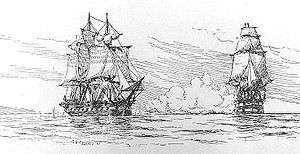
The British conducted raids on American shipping and kidnapped seamen in 1806–07; thousands of Americans were thus impressed into the British naval service. In 1806, Jefferson issued a call for a boycott of British goods; on April 18, Congress passed the Non-Importation Acts, but they were never enforced. Later that year, Jefferson asked James Monroe and William Pinkney to negotiate with Great Britain to end the harassment of American shipping, though Britain showed no signs of improving relations. The Monroe–Pinkney Treaty was finalized but lacked any provisions to end impressment, and Jefferson refused to submit it to the Senate for ratification.[189]
The British ship HMS Leopard fired upon the USS Chesapeake off the Virginia coast in June 1807, and Jefferson prepared for war.[190] He issued a proclamation banning armed British ships from U.S. waters. He presumed unilateral authority to call on the states to prepare 100,000 militia and ordered the purchase of arms, ammunition, and supplies, writing, "The laws of necessity, of self-preservation, of saving our country when in danger, are of higher obligation [than strict observance of written laws]". The USS Revenge was dispatched to demand an explanation from the British government; it also was fired upon. Jefferson called for a special session of Congress in October to enact an embargo or alternatively to consider war.[191]
In December, news arrived that Napoleon had extended the Berlin Decree, globally banning British imports. In Britain, King George III ordered redoubling efforts at impressment, including American sailors. But the war fever of the summer faded; Congress had no appetite to prepare the U.S. for war. Jefferson asked for and received the Embargo Act, an alternative that allowed the U.S. more time to build up defensive works, militias, and naval forces. Later historians have seen irony in Jefferson's assertion of such federal power. Meacham claims that the Embargo Act was a projection of power which surpassed the Alien and Sedition Acts, and R.B. Bernstein writes that Jefferson "was pursuing policies resembling those he had cited in 1776 as grounds for independence and revolution".[192]
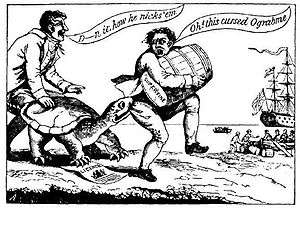
Secretary of State James Madison supported the embargo with equal vigor to Jefferson,[193] while Treasury Secretary Gallatin opposed it, due to its indefinite time frame and the risk that it posed to the policy of American neutrality.[194] The U.S. economy suffered, criticism grew, and opponents began evading the embargo. Instead of retreating, Jefferson sent federal agents to secretly track down smugglers and violators.[195] Three acts were passed in Congress during 1807 and 1808, called the Supplementary, the Additional, and the Enforcement acts.[190] The government could not prevent American vessels from trading with the European belligerents once they had left American ports, although the embargo triggered a devastating decline in exports.[190]
Most historians consider Jefferson's embargo to have been ineffective and harmful to American interests.[196] Appleby describes the strategy as Jefferson's "least effective policy", and Joseph Ellis calls it "an unadulterated calamity".[197] Others, however, portray it as an innovative, nonviolent measure which aided France in its war with Britain while preserving American neutrality.[198] Jefferson believed that the failure of the embargo was due to selfish traders and merchants showing a lack of "republican virtue." He maintained that, had the embargo been widely observed, it would have avoided war in 1812.[199]
In December 1807, Jefferson announced his intention not to seek a third term. He turned his attention increasingly to Monticello during the last year of his presidency, giving Madison and Gallatin almost total control of affairs.[200] Shortly before leaving office in March 1809, Jefferson signed the repeal of the Embargo. In its place, the Non-Intercourse Act was passed, but it proved no more effective.[190] The day before Madison was inaugurated as his successor, Jefferson said that he felt like "a prisoner, released from his chains".[201]
Retirement and later years
Following his retirement from the presidency, Jefferson continued his pursuit of educational interests; he sold his vast collection of books to the Library of Congress, and founded and built the University of Virginia.[202] Jefferson continued to correspond with many of the country's leaders, and the Monroe Doctrine bears a strong resemblance to solicited advice that Jefferson gave to Monroe in 1823.[203] As he settled into private life at Monticello, Jefferson developed a daily routine of rising early. He would spend several hours writing letters, with which he was often deluged. In the midday, he would often inspect the plantation on horseback. In the evenings, his family enjoyed leisure time in the gardens; late at night, Jefferson would retire to bed with a book.[204] However, his routine was often interrupted by uninvited visitors and tourists eager to see the icon in his final days, turning Monticello into "a virtual hotel".[205]
University of Virginia
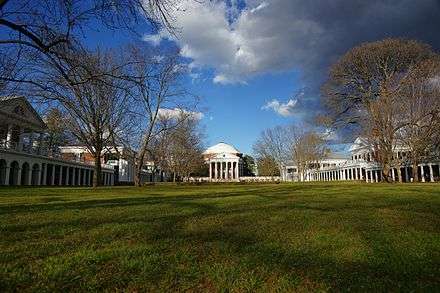
Jefferson envisioned a university free of church influences where students could specialize in many new areas not offered at other colleges. He believed that education engendered a stable society, which should provide publicly funded schools accessible to students from all social strata, based solely on ability.[206] He initially proposed his University in a letter to Joseph Priestley in 1800[207] and, in 1819, the 76-year-old Jefferson founded the University of Virginia. He organized the state legislative campaign for its charter and, with the assistance of Edmund Bacon, purchased the location. He was the principal designer of the buildings, planned the university's curriculum, and served as the first rector upon its opening in 1825.[208]
Jefferson was a strong disciple of Greek and Roman architectural styles, which he believed to be most representative of American democracy. Each academic unit, called a pavilion, was designed with a two-story temple front, while the library "Rotunda" was modeled on the Roman Pantheon. Jefferson referred to the university's grounds as the "Academical Village," and he reflected his educational ideas in its layout. The ten pavilions included classrooms and faculty residences; they formed a quadrangle and were connected by colonnades, behind which stood the students' rows of rooms. Gardens and vegetable plots were placed behind the pavilions and were surrounded by serpentine walls, affirming the importance of the agrarian lifestyle.[209] The university had a library rather than a church at its center, emphasizing its secular nature—a controversial aspect at the time.[210]
When Jefferson died in 1826, James Madison replaced him as rector.[211] Jefferson bequeathed most of his library to the university.[212]
Reconciliation with Adams
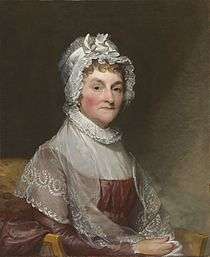
Jefferson and John Adams had been good friends in the first decades of their political careers, serving together in the Continental Congress in the 1770s and in Europe in the 1780s. The Federalist/Republican split of the 1790s divided them, however, and Adams felt betrayed by Jefferson's sponsorship of partisan attacks, such as those of James Callender. Jefferson, on the other hand, was angered at Adams for his appointment of "midnight judges".[213] The two men did not communicate directly for more than a decade after Jefferson succeeded Adams as president.[214] A brief correspondence took place between Abigail Adams and Jefferson after Jefferson's daughter "Polly" died in 1804, in an attempt at reconciliation unknown to Adams. However, an exchange of letters resumed open hostilities between Adams and Jefferson.[213]
As early as 1809, Benjamin Rush, signer of the Declaration of Independence, desired that Jefferson and Adams reconcile and began to prod the two through correspondence to re-establish contact.[213] In 1812, Adams wrote a short New Year's greeting to Jefferson, prompted earlier by Rush, to which Jefferson warmly responded. Thus began what historian David McCullough calls "one of the most extraordinary correspondences in American history".[215] Over the next fourteen years, the former presidents exchanged 158 letters discussing their political differences, justifying their respective roles in events, and debating the revolution's import to the world.[216] When Adams died, his last words included an acknowledgement of his longtime friend and rival: "Thomas Jefferson survives", unaware that Jefferson had died several hours before.[217][218]
Autobiography
In 1821, at the age of 77 Jefferson began writing his autobiography, in order to "state some recollections of dates and facts concerning myself."[219] He focused on the struggles and achievements he experienced until July 29, 1790, where the narrative stopped short.*[220] He excluded his youth, emphasizing the revolutionary era. He related that his ancestors came from Wales to America in the early 17th century and settled in the western frontier of the Virginia colony, which influenced his zeal for individual and state rights. Jefferson described his father as uneducated, but with a "strong mind and sound judgement." His enrollment in the College of William and Mary and election to the Continental Congress in Philadelphia in 1775 were included.[219]
He also expressed opposition to the idea of a privileged aristocracy made up of large land owning families partial to the King, and instead promoted "the aristocracy of virtue and talent, which nature has wisely provided for the direction of the interests of society, & scattered with equal hand through all it's conditions, was deemed essential to a well ordered republic." [219]
Jefferson gave his insight about people, politics, and events.[219] The work is primarily concerned with the Declaration and reforming the government of Virginia. He used notes, letters, and documents to tell many of the stories within the autobiography. He suggested that this history was so rich that his personal affairs were better overlooked, but he incorporated a self-analysis using the Declaration and other patriotism.[221]
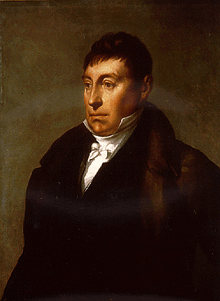
Lafayette's visit
In the summer of 1824, the Marquis de Lafayette accepted an invitation from President James Monroe to visit the country. Jefferson and Lafayette had not seen each other since 1789. After visits to New York, New England, and Washington, Lafayette arrived at Monticello on November 4.[208]
Jefferson's grandson Randolph was present and recorded the reunion: "As they approached each other, their uncertain gait quickened itself into a shuffling run, and exclaiming, 'Ah Jefferson!' 'Ah Lafayette!', they burst into tears as they fell into each other's arms." Jefferson and Lafayette then retired to the house to reminisce.[222] The next morning Jefferson, Lafayette, and James Madison attended a tour and banquet at the University of Virginia. Jefferson had someone else read a speech he had prepared for Lafayette, as his voice was weak and could not carry. This was his last public presentation. After an 11-day visit, Lafayette bid Jefferson goodbye and departed Monticello.[223]
Final days, death, and burial
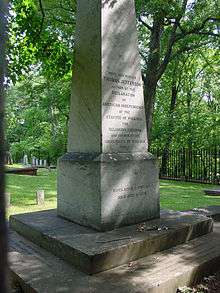
Jefferson's approximately $100,000 of debt weighed heavily on his mind in his final months, as it became increasingly clear that he would have little to leave to his heirs. In February 1826, he successfully applied to the General Assembly to hold a public lottery as a fund raiser.[224] His health began to deteriorate in July 1825, due to a combination of rheumatism from arm and wrist injuries, as well as intestinal and urinary disorders[208] and, by June 1826, he was confined to bed.[224] On July 3, Jefferson was overcome by fever and declined an invitation to Washington to attend an anniversary celebration of the Declaration.[225]
During the last hours of his life, he was accompanied by family members and friends. On July 4 at 12:50 p.m., Jefferson died at age 83 on the fiftieth anniversary of the Declaration of Independence, and just a few hours before the death of John Adams.[226][227] The sitting president was Adams' son John Quincy, and he called the coincidence of their deaths on the nation's anniversary "visible and palpable remarks of Divine Favor".[228]
Shortly after Jefferson had died, attendants found a gold locket on a chain around his neck, where it had rested for more than forty years, containing a small faded blue ribbon which tied a lock of his wife Martha's brown hair.[229]
Jefferson's remains were buried at Monticello, under a self-written epitaph:
HERE WAS BURIED THOMAS JEFFERSON, AUTHOR OF THE DECLARATION OF AMERICAN INDEPENDENCE, OF THE STATUTE OF VIRGINIA FOR RELIGIOUS FREEDOM, AND FATHER OF THE UNIVERSITY OF VIRGINIA.[230]
Jefferson died deeply in debt, unable to pass on his estate freely to his heirs.[231] He gave instructions in his will for disposal of his assets,[232] including the freeing of Sally Hemings' children;[233] but his estate, possessions, and slaves were sold at public auctions starting in 1827.[234] In 1831, Monticello was sold by Martha Jefferson Randolph and the other heirs.[235]
Political, social, and religious views
Jefferson subscribed to the political ideals expounded by John Locke, Francis Bacon, and Isaac Newton, whom he considered the three greatest men that ever lived.[236][237] He was also influenced by the writings of Gibbon, Hume, Robertson, Bolingbroke, Montesquieu, and Voltaire.[238] Jefferson thought that the independent yeoman and agrarian life were ideals of republican virtues. He distrusted cities and financiers, favored decentralized government power, and believed that the tyranny that had plagued the common man in Europe was due to corrupt political establishments and monarchies. He supported efforts to disestablish the Church of England[239] wrote the Virginia Statute for Religious Freedom, and he pressed for a wall of separation between church and state.[240] The Republicans under Jefferson were strongly influenced by the 18th-century British Whig Party, who believed in limited government.[241] His Democratic-Republican Party became dominant in early American politics, and his views became known as Jeffersonian democracy.[242][243]
Society and government
According to Jefferson's philosophy, citizens have "certain inalienable rights" and "rightful liberty is unobstructed action according to our will, within limits drawn around us by the equal rights of others."[244] A staunch advocate of the jury system to protect people's liberties, he proclaimed in 1801, "I consider [trial by jury] as the only anchor yet imagined by man, by which a government can be held to the principles of its constitution." [245] Jeffersonian government not only prohibited individuals in society from infringing on the liberty of others, but also restrained itself from diminishing individual liberty as a protection against tyranny from the majority.[246] Initially, Jefferson favored restricted voting to those who could actually have free exercise of their reason by escaping any corrupting dependence on others. He advocated enfranchising a majority of Virginians, seeking to expand suffrage to include "yeoman farmers" who owned their own land while excluding tenant farmers, city day laborers, vagrants, most Amerindians, and women.[247]
He was convinced that individual liberties were the fruit of political equality, which were threatened by arbitrary government.[248] Excesses of democracy in his view were caused by institutional corruptions rather than human nature. He was less suspicious of a working democracy than many contemporaries.[247] As president, Jefferson feared that the Federalist system enacted by Washington and Adams had encouraged corrupting patronage and dependence. He tried to restore a balance between the state and federal governments more nearly reflecting the Articles of Confederation, seeking to reinforce state prerogatives where his party was in a majority.[247]
Jefferson was steeped in the British Whig tradition of the oppressed majority set against a repeatedly unresponsive court party in the Parliament. He justified small outbreaks of rebellion as necessary to get monarchial regimes to amend oppressive measures compromising popular liberties. In a republican regime ruled by the majority, he acknowledged "it will often be exercised when wrong".[249] But "the remedy is to set them right as to facts, pardon and pacify them." [250] As Jefferson saw his party triumph in two terms of his presidency and launch into a third term under James Madison, his view of the U.S. as a continental republic and an "empire of liberty" grew more upbeat. On departing the presidency in 1809, he described America as "trusted with the destines of this solitary republic of the world, the only monument of human rights, and the sole depository of the sacred fire of freedom and self-government".[251]
Democracy

Jefferson considered democracy to be the expression of society, and promoted national self-determination, cultural uniformity, and education of all males of the commonwealth.[252] He supported public education and a free press as essential components of a democratic nation.[253]
After resigning as secretary of state in 1795, Jefferson focused on the electoral bases of the Republicans and Federalists. The "Republican" classification for which he advocated included "the entire body of landholders" everywhere and "the body of laborers" without land.[254] Republicans united behind Jefferson as vice president, with the election of 1796 expanding democracy nationwide at grassroots levels.[255] Jefferson promoted Republican candidates for local offices.[256]
Beginning with Jefferson's electioneering for the "revolution of 1800", his political efforts were based on egalitarian appeals.[257] In his later years, he referred to the 1800 election "as real a revolution in the principles of our government as that of '76 was in its form", one "not effected indeed by the sword ... but by the ... suffrage of the people."[258] Voter participation grew during Jefferson's presidency, increasing to "unimaginable levels" compared to the Federalist Era, with turnout of about 67,000 in 1800 rising to about 143,000 in 1804.[259]
At the onset of the Revolution, Jefferson accepted William Blackstone's argument that property ownership would sufficiently empower voters' independent judgement, but he sought to further expand suffrage by land distribution to the poor.[260] In the heat of the Revolutionary Era and afterward, several states expanded voter eligibility from landed gentry to all propertied male, tax-paying citizens with Jefferson's support.[261] In retirement, he gradually became critical of his home state for violating "the principle of equal political rights"—the social right of universal male suffrage.[262] He sought a "general suffrage" of all taxpayers and militia-men, and equal representation by population in the General Assembly to correct preferential treatment of the slave-holding regions.[263]
Religion
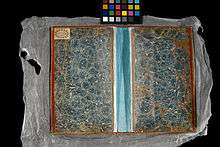
Baptized in his youth, Jefferson became a governing member of his local Episcopal Church in Charlottesville, which he later attended with his daughters.[264] Influenced by Deist authors during his college years Jefferson abandoned "orthodox" Christianity after his review of New Testament teachings.[265][266] In 1803 he asserted, "I am Christian, in the only sense in which [Jesus] wished any one to be."[168] Jefferson later defined being a Christian as one who followed the simple teachings of Jesus. Jefferson compiled Jesus' biblical teachings, omitting miraculous or supernatural references. He titled the work The Life and Morals of Jesus of Nazareth, known today as the Jefferson Bible.[267] Peterson states Jefferson was a theist "whose God was the Creator of the universe ... all the evidences of nature testified to His perfection; and man could rely on the harmony and beneficence of His work."[268]
Jefferson was firmly anticlerical, writing in "every age, the priest has been hostile to liberty ... they have perverted the purest religion ever preached to man into mystery and jargon."[269] The full letter to Horatio Spatford can be read at the National Archives.[270] Jefferson once supported banning clergy from public office but later relented.[271] In 1777, he drafted the Virginia Statute for Religious Freedom. Ratified in 1786, it made compelling attendance or contributions to any state-sanctioned religious establishment illegal and declared that men "shall be free to profess ... their opinions in matters of religion."[272] The Statute is one of only three accomplishments he chose to have inscribed in the epitaph on his gravestone.[273][274] Early in 1802, Jefferson wrote to the Danbury Connecticut Baptist Association, "that religion is a matter which lies solely between Man and his God." He interpreted the First Amendment as having built "a wall of separation between Church and State."[275] The phrase 'Separation of Church and State' has been cited several times by the Supreme Court in its interpretation of the Establishment Clause.
Jefferson donated to the American Bible Society, saying the Four Evangelists delivered a "pure and sublime system of morality" to humanity. He thought Americans would rationally create "Apiarian" religion, extracting the best traditions of every denomination.[276] And he contributed generously to several local denominations nearby Monticello.[277] Acknowledging organized religion would always be factored into political life for good or ill, he encouraged reason over supernatural revelation to make inquiries into religion. He believed in a creator god, an afterlife, and the sum of religion as loving God and neighbors. But he also controversially renounced the conventional Christian Trinity, denying Jesus' divinity as the Son of God.[278][279]
Jefferson's unorthodox religious beliefs became an important issue in the 1800 presidential election.[280] Federalists attacked him as an atheist. As president, Jefferson countered the accusations by praising religion in his inaugural address and attending services at the Capitol.[280]
Banks
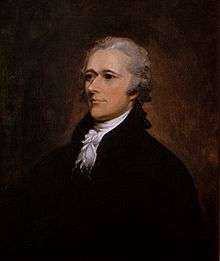
Jefferson distrusted government banks and opposed public borrowing, which he thought created long-term debt, bred monopolies, and invited dangerous speculation as opposed to productive labor.[281] In one letter to Madison, he argued each generation should curtail all debt within 19 years, and not impose a long-term debt on subsequent generations.[282]
In 1791, President Washington asked Jefferson, then Secretary of State, and Hamilton, the Secretary of the Treasury, if the Congress had the authority to create a national bank. While Hamilton believed Congress had the authority, Jefferson and Madison thought a national bank would ignore the needs of individuals and farmers, and would violate the Tenth Amendment by assuming powers not granted to the federal government by the states.[283]
Jefferson used agrarian resistance to banks and speculators as the first defining principle of an opposition party, recruiting candidates for Congress on the issue as early as 1792.[284] As president, Jefferson was persuaded by Secretary of Treasury Albert Gallatin to leave the bank intact, but sought to restrain its influence.[285][lower-alpha 12]
Slavery

Jefferson lived in a planter economy largely dependent upon slavery, and as a wealthy landholder, used slave labor for his household, plantation, and workshops. He first recorded his slaveholding in 1774, when he counted 41.[287] Over his lifetime he owned about 600 slaves; he inherited about 175 while most of the remainder were born on his plantations.[288] Jefferson purchased slaves in order to unite their families, and he sold about 110 for economic reasons, primarily slaves from his outlying farms.[288][289] Many historians have described Jefferson as a benevolent slaveowner[290] who didn't overwork his slaves by the conventions of his time, and provided them log cabins with fireplaces, food, clothing and some household provisions, though slaves often had to make many of their own provisions. Additionally Jefferson gave his slaves financial and other incentives while also allowing them to grow gardens and raise their own chickens. The use of the whip was employed only in rare and extreme cases of fighting and stealing.[288][291]
Jefferson once said, "My first wish is that the labourers may be well treated".[288] Slaves were given Sundays and Christmas off and had more free time during the winter months.[292] Some scholars doubt Jefferson's benevolence,[293] however, noting cases of excessive slave whippings in his absence. His nail factory was also only staffed by child slaves, many of those boys became tradesmen. Burwell Colbert, who started his working life as a child in Monticello's Nailery, was later promoted to the supervisory position of butler.[294]
Jefferson felt slavery was harmful to both slave and master, but had reservations about releasing unprepared slaves into freedom and advocated gradual emancipation.[295][296][297] In 1779, he proposed gradual voluntary training and resettlement to the Virginia legislature, and three years later drafted legislation allowing owners to free their own slaves.[298] In his draft of the Declaration of Independence, he included a section, stricken by other Southern delegates, criticizing King George III's role in promoting slavery in the colonies.[299] In 1784, Jefferson proposed the abolition of slavery in all western U.S. territories, limiting slave importation to 15 years.[300] Congress, however, failed to pass his proposal by one vote.[300] In 1787, Congress passed the Northwest Ordinance, a partial victory for Jefferson that terminated slavery in the Northwest Territory. Jefferson freed his slave Robert Hemings in 1794 and he freed his cook slave James Hemings in 1796.[301] During his presidency Jefferson allowed the diffusion of slavery into the Louisiana Territory hoping to prevent slave uprisings in Virginia and to prevent South Carolina secession.[302] In 1804, in a compromise on the slavery issue, Jefferson and Congress banned domestic slave trafficking for one year into the Louisiana Territory.[303] In 1806 he officially called for anti-slavery legislation terminating the import or export of slaves. Congress passed the law in 1807, taking effect in 1818.[295][304][305] In 1819, he strongly opposed a Missouri statehood application amendment that banned slave importation and freed slaves at the age of 25 on grounds it would destroy the union.[306] Jefferson freed his runaway slave Harriet Hemings in 1822.[307] Upon his death in 1826, Jefferson freed five male Hemings slaves in his will.[308]
Jefferson shared the common belief of his day that blacks were mentally and physically inferior, but argued they nonetheless had innate human rights.[295][309] In Notes on the State of Virginia, he created controversy by calling slavery a moral evil for which the nation would ultimately have to account to God.[310] He therefore supported colonization plans that would transport freed slaves to another country, such as Liberia or Sierra Leone, though he recognized the impracticability of such proposals.[311]
During his presidency Jefferson was for the most part publicly silent on the issue of slavery and emancipation,[312] as the Congressional debate over slavery and its extension caused a dangerous north-south rift among the states, with talk of a northern confederacy in New England.[313] [lower-alpha 13] The violent attacks on white slave owners during the Haitian Revolution due to injustices under slavery supported Jefferson's fears of a race war, increasing his reservations about promoting emancipation at that time.[295][314] After numerous attempts and failures to bring about emancipation,[315] Jefferson wrote privately in an 1805 letter to William A. Burwell, "I have long since given up the expectation of any early provision for the extinguishment of slavery among us." That same year he also related this idea to George Logan, writing, "I have most carefully avoided every public act or manifestation on that subject." [316]
Historical assessment
Scholars remain divided on whether Jefferson supported or condemned slavery and how he changed.[307][317] Francis D. Cogliano traces the development of competing emancipationist then revisionist and finally contextualist interpretations from the 1960s to the present. The emancipationist view, held by the various scholars at the Thomas Jefferson Foundation, Douglas L. Wilson, and others maintains Jefferson was an opponent of slavery all his life, noting that he did what he could within the limited range of options available to him to undermine it, his many attempts at abolition legislation, the manner in which he provided for slaves, and his advocacy of their more humane treatment.[291][318][319][lower-alpha 14] The revisionist view, advanced by Paul Finkelman and others criticizes Jefferson for racism, for holding slaves, and for acting contrary to his words, as Jefferson never freed most of his slaves, and he remained silent on the issue while he was President.[312][320] Contextualists such as Joseph J. Ellis emphasize a change in Jefferson's thinking from emancipationist before 1783, noting a shift toward public passivity and procrastination on policy issues related to slavery. Jefferson seemed to yield to public opinion by 1794 as he laid the groundwork for his first presidential campaign against Adams in 1796.[321]
Jefferson–Hemings controversy
Claims that Jefferson fathered Sally Hemings' children have been debated since 1802. That year James T. Callender, after being denied a position as postmaster, alleged Jefferson had taken Hemings as a concubine and fathered several children with her.[322] In 1998, a panel of researchers conducted a Y-DNA study of living descendants of Jefferson's uncle, Field, and of a descendant of Hemings' son, Eston Hemings. The results, published in the journal Nature, showed a match with the male Jefferson line.[323] According to the Thomas Jefferson Foundation, since the results of the DNA tests were made public, most historians believe Jefferson had a relationship with Hemings.[324] In 2000, the Thomas Jefferson Foundation (TJF) assembled a team of historians whose report concluded that "the DNA study ... indicates a high probability that Thomas Jefferson fathered Eston Hemings."[325][lower-alpha 15] Other scholars maintain the evidence is insufficient to prove Jefferson's paternity conclusively. They note the possibility that additional Jefferson males, including his brother Randolph Jefferson and Randolph's five sons, could have fathered Eston Hemings or Sally Hemings' other children.[327] After Thomas Jefferson's death, although not formally manumitted, Sally Hemings was allowed by Jefferson's daughter Martha to live in Charlottesville as a free woman until her death in 1835.[328][lower-alpha 16]
Interests and activities
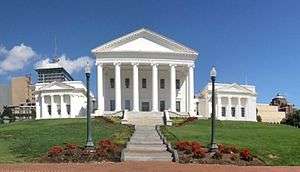
Jefferson was a farmer, obsessed with new crops, soil conditions, garden designs, and scientific agricultural techniques. His main cash crop was tobacco, but its price was usually low and it was rarely profitable. He tried to achieve self-sufficiency with wheat, vegetables, flax, corn, hogs, sheep, poultry, and cattle to supply his family, slaves, and employees, but he had cash flow problems and was always in debt.[330]
In the field of architecture, Jefferson helped popularize the Neo-Palladian style in the United States utilizing designs for the Virginia State Capitol, the University of Virginia, Monticello, and others.[331] Jefferson mastered architecture through self-study, using various books and classical architectural designs of the day. His primary authority was Andrea Palladio's The Four Books of Architecture, which outlines the principles of classical design.[332]
He was interested in birds and wine, and was a noted gourmet; he was also a prolific writer and linguist, and spoke several languages.[333] As a naturalist, he was fascinated by the Natural Bridge geological formation, and in 1774 successfully acquired the Bridge by grant from George III.[334]
American Philosophical Society
Jefferson was a member of the American Philosophical Society for 35 years, beginning in 1780. Through the Society he advanced the sciences and Enlightenment ideals, emphasizing that knowledge of science reinforced and extended freedom.[335] His Notes on the State of Virginia was written in part as a contribution to the Society.[336] He became the Society's third president on March 3, 1797, a few months after he was elected Vice President of the United States.[336][337] In accepting, Jefferson stated: "I feel no qualification for this distinguished post but a sincere zeal for all the objects of our institution and an ardent desire to see knowledge so disseminated through the mass of mankind that it may at length reach even the extremes of society, beggars and kings."[335]
Jefferson served as APS President for the next eighteen years, including through both terms of his presidency.[336] He introduced Meriwether Lewis to the Society, where various scientists tutored him in preparation for the Lewis and Clark Expedition.[336][338] He resigned on January 20, 1815, but remained active through correspondence.[339]
Linguistics
Jefferson had a lifelong interest in linguistics, could speak, read and write in a number of languages, including French, Greek, Italian, and German. In his early years he excelled in classical language while at boarding school[340] where he received a classical education in Greek and Latin.[341] Jefferson later came to regard the Greek language as the "perfect language" as expressed in its laws and philosophy.[342] While attending the College of William & Mary, he taught himself Italian.[343] Here Jefferson first became familiar with the Anglo-Saxon language, especially as it was associated with English Common law and system of government and studied the language in a linguistic and philosophical capacity. He owned 17 volumes of Anglo-Saxon texts and grammar and later wrote an essay on the Anglo-Saxon language.[340]
Jefferson claimed to have taught himself Spanish during his nineteen-day journey to France, using only a grammar guide and a copy of Don Quixote.[344] Linguistics played a significant role in how Jefferson modeled and expressed political and philosophical ideas. He believed that the study of ancient languages was essential in understanding the roots of modern language.[345] He collected and understood a number of American Indian vocabularies and instructed Lewis and Clark to record and collect various Indian languages during their Expedition.[346] When Jefferson removed from Washington after his presidency, he packed 50 Native American vocabulary lists in a chest and transported them on a river boat back to Monticello along with the rest of his possessions. Somewhere along the journey, a thief stole the heavy chest, thinking it was full of valuables, but its contents were dumped into the James River when the thief discovered it was only filled with papers. Subsequently, 30 years of collecting were lost, with only a few fragments rescued from the muddy banks of the river.[347]
Jefferson was not an outstanding orator and preferred to communicate through writing or remain silent if possible. Instead of delivering his State of the Union addresses himself, Jefferson wrote the annual messages and sent a representative to read them aloud in Congress. This started a tradition which continued until 1913, when President Woodrow Wilson (1913–1921) chose to deliver his own State of the Union address.[348]
Inventions
Jefferson invented many small practical devices and improved contemporary inventions, including a revolving book-stand and a "Great Clock" powered by the gravitational pull on cannonballs. He improved the pedometer, the polygraph (a device for duplicating writing),[349] and the moldboard plow, an idea he never patented and gave to posterity.[350] Jefferson can also be credited as the creator of the swivel chair, the first of which he created and used to write much of the Declaration of Independence.[351]
As Minister to France, Jefferson was impressed by the military standardization program known as the Système Gribeauval, and initiated a program as president to develop interchangeable parts for firearms. For his inventiveness and ingenuity, he received several honorary Doctor of Law degrees.[352]
Historical reputation
.jpg)
Jefferson is an icon of individual liberty, democracy, and republicanism, hailed as the author of the Declaration of Independence, an architect of the American Revolution, and a renaissance man who promoted science and scholarship.[353] The participatory democracy and expanded suffrage he championed defined his era and became a standard for later generations.[354] Meacham opined, he was the most influential figure of the democratic republic in its first half century, succeeded by presidential adherents James Madison, James Monroe, Andrew Jackson, and Martin Van Buren.[355] Jefferson is recognized for having written more than 18,000 letters of political and philosophical substance during his life, which Francis D. Cogliano describes as "a documentary legacy ... unprecedented in American history in its size and breadth."[356]
Jefferson's reputation declined during the Civil War due to his support of states' rights. In the late 19th century, his legacy was widely criticized; conservatives felt his democratic philosophy had led to that era's populist movement, while Progressives sought a more activist federal government than Jefferson's philosophy allowed. Both groups saw Hamilton as vindicated by history, rather than Jefferson, and President Woodrow Wilson even described Jefferson as "though a great man, not a great American".[357]
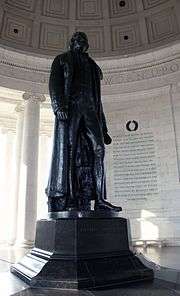
Memorial Statue
In the 1930s, Jefferson was held in higher esteem; President Franklin D. Roosevelt (1933–45) and New Deal Democrats celebrated his struggles for "the common man" and reclaimed him as their party's founder. Jefferson became a symbol of American democracy in the incipient Cold War, and the 1940s and '50s saw the zenith of his popular reputation.[358] Following the African-American Civil Rights movement of the 1950s and '60s, Jefferson's slaveholding came under new scrutiny, particularly after a DNA test supported allegations he had a relationship with Sally Hemings.[359]
Noting the huge output of scholarly books on Jefferson in recent years, historian Gordon Wood summarizes the raging debates about Jefferson's stature:
- Although many historians and others are embarrassed about his contradictions and have sought to knock him off the democratic pedestal ... his position, though shaky, still seems secure."[360]
The Siena Research Institute poll of presidential scholars, begun in 1982, has consistently ranked Jefferson as one of the five best U.S. presidents,[361] and a 2015 Brookings Institution poll of American Political Science Association members ranked him as the fifth greatest president.[362]
Memorials and honors
-3_new.jpg)
Jefferson has been memorialized with buildings, sculptures, postage, and currency. In the 1920s, Jefferson, together with George Washington, Theodore Roosevelt, and Abraham Lincoln, was chosen by sculptor Gutzon Borglum and approved by President Calvin Coolidge to be depicted in stone at the Mount Rushmore Memorial.[363]
The Jefferson Memorial was dedicated in Washington, D.C. in 1943, on the 200th anniversary of Jefferson's birth. The interior of the memorial includes a 19-foot (6 m) statue of Jefferson and engravings of passages from his writings. Most prominent are the words inscribed around the monument near the roof: "I have sworn upon the altar of God eternal hostility against every form of tyranny over the mind of man."[364]
Writings
| Library resources about Thomas Jefferson |
| By Thomas Jefferson |
|---|
- A Summary View of the Rights of British America (1774)
- Declaration of the Causes and Necessity of Taking Up Arms (1775)
- Declaration of Independence (1776)
- Memorandums taken on a journey from Paris into the southern parts of France and Northern Italy, in the year 1787
- Notes on the State of Virginia (1781)
- Plan for Establishing Uniformity in the Coinage, Weights, and Measures of the United States A report submitted to Congress (1790)
- "An Essay Towards Facilitating Instruction in the Anglo-Saxon and Modern Dialects of the English Language" (1796)
- Manual of Parliamentary Practice for the Use of the Senate of the United States (1801)
- Autobiography (1821)
- Jefferson Bible, or The Life and Morals of Jesus of Nazareth
See also
- List of Presidents of the United States by previous experience
- List of Presidents of the United States who owned slaves
- List of abolitionist forerunners
- Jefferson Monroe Levy
Notes
- ↑ Jefferson personally showed little interest in his ancestry; on his father's side, he only knew of the existence of his grandfather.[2][3] Malone writes that Jefferson vaguely knew that his grandfather "had a place on the Fluvanna River which he called Snowden after a mountain in Wales near which the Jeffersons were supposed to have once lived".[2]
- ↑ His other properties included Shadwell, Tufton, Lego, Pantops, and his retreat Poplar Forest. He also owned the unimproved mountaintop Montalto, and the Natural Bridge.[21]
- ↑ Adams recorded his exchange with Jefferson on the question. Jefferson asked, "Why will you not? You ought to do it." To which Adams responded, "I will not—reasons enough." Jefferson replied, "What can be your reasons?" And Adams responded, "Reason first, you are a Virginian, and a Virginian ought to appear at the head of this business. Reason second, I am obnoxious, suspected, and unpopular. You are very much otherwise. Reason third, you can write ten times better than I can." "Well," said Jefferson, "if you are decided, I will do as well as I can." Adams concluded, "Very well. When you have drawn it up, we will have a meeting."[36]
- ↑ Franklin, seated beside the author, observed him "writhing a little under the acrimonious criticisms on some of its parts."[40]
- ↑ the immediate successor to the Second Continental Congress
- ↑ An example can be seen at the Library of Congress website.
- ↑ Jefferson's Kentucky draft said: "where powers are assumed which have not been delegated, a nullification of the act is the rightful remedy: that every State has a natural right in cases not within the compact, (casus non fœderis) to nullify of their own authority all assumptions of power by others within their limits."[103]
- ↑ This electoral process problem was addressed by the Twelfth Amendment to the United States Constitution in 1804, which provided separate votes for presidential and vice presidential candidates.[113]
- ↑ Louisiana nevertheless gained statehood nine years later in 1812.[148]
- ↑ Further complicating matters, Wilkinson was posthumously revealed to have been in the simultaneous pay of the British, French, and Spanish.[181]
- ↑ Burr then left for Europe and eventually returned to practicing law.
- ↑ The First Bank of the U.S. was eventually abolished in 1811 by a heavily Republican Congress.[286]
- ↑ Aaron Burr was offered help in obtaining the governorship of New York by Timothy Pickering if he could persuade New York to go along, but the secession effort failed when Burr lost the election.
- ↑ For examples of each historian's view, see Wilson, Douglas L., Thomas Jefferson and the Issue of Character, The Atlantic, Nov. 1992. Finkelman (1994) "Thomas Jefferson and Antislavery: The Myth Goes On" and Joseph J. Ellis, 1996, American Sphinx: the character of Thomas Jefferson
- ↑ The minority report from White Wallenborn stated that "the historical evidence is not substantial enough to confirm nor for that matter to refute his paternity of any of the children of Sally Hemings. The DNA studies certainly enhance the possibility but ... do not prove Thomas Jefferson's paternity".[326]
- ↑ Annette Gordon-Reed notes that it would have been legally challenging to free Sally Hemings, due to Virginia laws mandating the support of older slaves and requiring special permission for freed slaves to remain within the state.[329]
References
- ↑ Tucker, 1837, v. 1, p. 18.
- 1 2 3 Malone, 1948, pp. 5–6.
- ↑ Brodie, 1974, pp. 33–34.
- ↑ Malone, 1948, pp. 31–33.
- ↑ Malone, 1948, pp. 437–40.
- ↑ Tucker, 1837, v. 1, p. 19.
- ↑ Peterson, 1970, pp. 7–9.
- ↑ Meacham, 2012, pp. 29, 39.
- ↑ Meacham, 2012, pp. 19, 28–29.
- ↑ Tucker, 1837, v. 1, p. 42.
- ↑ Ferling, 2000, p. 43.
- ↑ Library of Congress
- ↑ Meacham, 2012, pp. 11, 49.
- ↑ Tucker, 1837, v. 1, p. 40.
- ↑ Meacham, 2012, pp. 47–49.
- ↑ Gordon-Reed, 2008, p. 348.
- 1 2 Gordon-Reed, 2008, pp. 99–100.
- ↑ Meacham, 2012, p. 49.
- ↑ Konig, David T., Encyclopedia Virginia
- ↑ Meacham, 2012, pp. 71–73.
- ↑ Bear, 1967, p. 51.
- ↑ TJF: Monticello (House) FAQ – "Who built the house?"
- ↑ Ellis, 1996, pp. 142–44.
- 1 2 Tucker, 1837, v. 1, p. 47.
- ↑ Roberts, 1993
- ↑ Malone, 1948, p. 53.
- ↑ Malone, 1948, pp. 47, 158.
- 1 2 White House Archives
- ↑ Gordon-Reed, 2008, p. 145; Meacham, 2012, p. 53.
- ↑ Halliday, 2009, pp. 48–53.
- ↑ TJF:Monticello Construction
- ↑ Bernstein, 2003, p. 109.
- ↑ Tucker, 1837, v. 1, p. 77.
- ↑ Meacham, 2012, pp. 103–04.
- ↑ Peterson, 1970, p. 87.
- ↑ Meacham, 2012, p. 102.
- ↑ Maier, 1997, p. 104.
- 1 2 Meacham, 2012, p. 105.
- 1 2 Ellis, 1996, p. 50.
- ↑ Tucker, 1837, p. 90.
- ↑ Meacham, 2012, p. 110.
- ↑ Ellis, 2008, pp. 55–56.
- ↑ Brodie, 1974, p. 112.
- 1 2 Peterson, 1970, pp. 101–02, 114, 140.
- ↑ Ferling, 2004, p. 26.
- ↑ Tucker, 1837, v. 1, p. 102; Bernstein, 2003, p. 42.
- ↑ Peterson, 1970, pp. 134, 142; Bernstein, 2003, pp. 68–69.
- ↑ Tucker, 1837, v. 1, p. 134.
- ↑ Tucker, 1837, v. 1, p. 137.
- ↑ Peterson, 1970, pp. 234–38.
- ↑ Meacham, 2012, pp. 133–35; Ellis, 1996, p. 66; Gordon-Reed, 2008, pp. 136–37.
- ↑ Tucker, 1837, v. 1, p. 157.
- ↑ Meacham, 2012, pp. 140–42.
- ↑ Tucker, 1837, v. 1, p. 263.
- ↑ Tucker, 1837, v. 1, pp. 165–66.
- ↑ Shuffelton, 1999
- ↑ Notes on the State of Virginia, p. 149; Burstein, 2006, p. 146.
- ↑ Notes on the State of Virginia, 1853, Query XI
- ↑ TJF: Thomas Jefferson's Enlightenment and American Indians
- ↑ Bernstein, 2004, p. 78.
- ↑ Tucker, 1837, v. 1, p. 166.
- ↑ Peterson, 1970, ch. 5.
- ↑ Tucker, 1837, v. 1, pp. 172–73.
- ↑ Peterson, 1970, p. 275.
- ↑ Rayner, 1834, p. 207.
- 1 2 Peterson, 1960, pp. 189–90.
- ↑ Finkelman, 1989, pp. 21–51.
- ↑ Peterson, 1970, pp. 289–94.
- ↑ Stewart, 1997, p. 39.
- ↑ Meacham, 2012, p. 180.
- ↑ McCullough, 2001, p. 330.
- ↑ Tucker, 1837, v. 1, p. 194.
- ↑ TJF: Maria Cosway (Engraving)
- ↑ Gordon-Reed, 2008, pp. 156, 164–68.
- 1 2 "Memoirs of Madison Hemings". Frontline. Public Broadcasting Service – WGBH Boston. Retrieved 29 November 2011.
- ↑ Bowers, 1945, p. 328.
- ↑ Burstein, 2010, p. 120.
- ↑ Meacham, 2012, pp. 222–23.
- ↑ TJF: Coded Messages
- ↑ Ellis, 1996, pp. 116–17.
- ↑ Ellis, 1996, p. 110; Wood, 2010, pp. 179–81.
- ↑ Tucker, 1837, v. 1, p. 334.
- 1 2 Randall (1996), p. 1.
- ↑ Tucker, 1837, v. 1, pp. 364–69.
- ↑ Chernow, 2004, p. 427.
- 1 2 Cooke, 1970, pp. 523–45.
- ↑ Tucker, 1837, v. 1, p. 429.
- ↑ Greider, 2010, p. 246.
- ↑ Wood, 2010, pp. 145–49.
- ↑ Wood, 2010, pp. 186–88.
- ↑ Ellis, 1996, p. 119; Meacham, 2012, pp. 283–84; Tucker, 1837, v. 1, p. 523.
- ↑ Meacham, 2012, pp. 293–94.
- ↑ Peterson, 1970, ch.8 [e-book].
- ↑ Yarbrough, 2006, p. xx.
- ↑ Meacham, 2012, p. 305.
- ↑ Bernstein, 2003, pp. 117–18.
- ↑ Elkins, 1994, p. 566.
- ↑ Chernow, 2004, p. 550.
- ↑ Meacham, 2012, p. 312.
- ↑ Tucker, 1837, v. 2, p. 54.
- ↑ Wood, 2010, pp. 269–71.
- ↑ Meacham, 2012, p. 318.
- ↑ Thomas Jefferson, Resolutions Relative to the Alien and Sedition Acts, 1798
- ↑ Onuf, 2000, p. 73.
- ↑ Chernow, 2004, p. 574.
- ↑ Chernow, 2004, p. 587.
- ↑ Bernstein, 2003, p. 96.
- ↑ Meacham, 2012, p. 323.
- ↑ Bernstein, 2003, pp. 126–28; McCullough, 2001, p. 556.
- ↑ McCullough, 2001, pp. 543–44.
- ↑ Appleby, 2003, pp. 27–28.
- ↑ Tucker, 1837, v. 2, p. 75; Wood, 2010, p. 278.
- 1 2 3 4 Wood, 2010, pp. 284–85.
- ↑ Meacham, 2012, pp. 340–41.
- ↑ Ferling, 2004, p. 208.
- ↑ Meacham, 2012, pp. 337–38.
- ↑ Wood, 2010, pp. 287–88.
- ↑ Hale, 1896, Illustrious Americans, p. 124.
- ↑ Meacham, 2012, pp. 348–50.
- 1 2 Peterson (2002), p. 40.
- 1 2 Peterson, 2002, p. 41.
- 1 2 3 4 Meacham, 2012, p. 387.
- 1 2 Wood, 2010, p. 293.
- ↑ Bailey, 2007, p. 216.
- ↑ Wills, 2002, pp. 50–51.
- ↑ Chernow, 2004, p. 671.
- ↑ Meacham, 2012, p. 357.
- ↑ Meacham, 2012, p. 375.
- ↑ Urofsky, 2006, p. viii.
- ↑ Scythes, 2014, pp. 693–94.
- ↑ Scythes, 2014, pp. 422–23.
- ↑ Fremont-Barnes, 2006, p. 32.
- ↑ Fremont-Barnes, 2006, p. 36.
- ↑ First Barbary War
- 1 2 Meacham, 2012, pp. 364–65.
- ↑ Herring, 2008, p. 97.
- ↑ Wood, 2010, p. 638.
- ↑ Bernstein. 2003, p. 146.
- ↑ Wood, 2010, p. 639.
- ↑ Meacham, 2012, pp. 383–84.
- ↑ Wood, 2010, p. 368.
- 1 2 Freehling, 2005, p. 69.
- 1 2 Ellis, 2008, pp. 207–08.
- ↑ Wilentz, 2005, p. 108.
- ↑ Meecham, 2012, pp. 389–90.
- ↑ Tucker, 1837, v. 2, pp. 152–54.
- ↑ Peterson, 1970, p. 777; Wood, 2010, p. 372; Ellis, 2008, p. 230.
- ↑ Wood, 2010, p. 373.
- ↑ Ellis, 2008, pp. 231–32.
- ↑ Ambrose, 1996, pp. 76, 418.
- ↑ Ambrose, 1996, p. 154.
- ↑ Rodriguez, 2002, pp. xxiv, 162, 185.
- ↑ Rodriguez, 2002, pp. 112, 186.
- ↑ Ambrose, 1996, pp. 54, 80.
- ↑ Ambrose, 1996, pp. 154, 409, 512.
- ↑ Berry, 2006, p. xi.
- ↑ TJF: American Indians
- ↑ Miller, 2008, p. 90.
- 1 2 Sheehan, 1974, pp. 120–21.
- ↑ Peterson, 1970, ch. 9.
- ↑ TJF: President Jefferson and the Indian Nations
- ↑ The Life and Writings of Thomas Jefferson, pp. 265–66.
- ↑ Miller, 2008, p. 94.
- 1 2 Meacham, 2012, pp. 405–06.
- ↑ Meacham, 2012, pp. 415–17.
- ↑ Tucker, 1837, v. 2, pp. 291–94.
- ↑ Miller, 1980, pp. 145–46.
- 1 2 Randall, 1994, p. 583.
- ↑ Kaplan, 1999, p. 407.
- 1 2 3 Peterson, 2002, p. 49.
- ↑ Jefferson, Haiti The Journal of Southern History 61, no. 2 (May 1995), p. 221.
- ↑ Bernstein, 2003, pp. 146–47.
- ↑ Malone, 1981, p. 11.
- ↑ Chernow, 2004, p. 714.
- ↑ Wood, 2010, pp. 385–86.
- ↑ Banner (1974), p. 34.
- 1 2 Banner (1974), pp. 34–35.
- 1 2 The Burr Conspiracy (2000)
- 1 2 3 Peterson (2002), p. 50.
- ↑ Wood, 2010, pp. 385–86; Meacham, 2012, pp. 420, 422.
- ↑ Bernstein, 2003, pp. 161–62.
- ↑ Meacham, 2012, p. 420.
- 1 2 Banner (1974), p. 37.
- ↑ Appleby, 2003, p. 100; Bernstein, 2003, p. 162.
- ↑ Bernstein, 2003, pp. 163–64; Meacham, 2012, pp. 422–23.
- ↑ Banner, 1974, p. 37.
- ↑ Bernstein, 2003, p. 165.
- ↑ Appleby, 2003, p. 101.
- ↑ Hayes, 2008, pp. 504–05.
- 1 2 3 4 TJF: Embargo of 1807
- ↑ Meacham, 2012, pp. 425–29.
- ↑ Meacham, 2012, p. 430; Bernstein, 2003, p. 168.
- ↑ Burstein, 2010, pp. 497–98.
- ↑ Meacham, 2012, p. 430.
- ↑ Tucker, 1990, v. 1, pp. 204–09, 232.
- ↑ Cogliano, 2008, p. 250; Meacham, 2012, p. 475.
- ↑ Appleby, 2003, p. 145; Ellis, 1996, p. 237.
- ↑ Hayes, 2008, pp. 504–05; Kaplan, 1999, pp. 166–68.
- ↑ Hayes, 2008, pp. 504–05; Peterson, 1960, pp. 289–90.
- ↑ Ellis, 1996, p. 238; Appleby, 2003, pp. 128–29.
- ↑ Ellis, 1996, p. 238.
- ↑ Tucker, 1837, v. 2, p. 479.
- ↑ Meacham, 2012, pp. 481–82.
- ↑ TJF: I Rise with the Sun
- ↑ Ellis, 1996, p. 232; Meacham, 2012, pp. 463–65.
- ↑ U Va. Library
- ↑ Adams, 1888, p. 48.
- 1 2 3 Peterson, 1970, ch. 11 [e-book].
- ↑ Hogan, 1987, pp. 28–29.
- ↑ Gordon-Reed, 2008, p. 649.
- ↑ TJF: James Madison
- ↑ Crawford, 2008, p. 235.
- 1 2 3 Freeman, 2008, p. 12.
- ↑ Ellis, 2003, pp. 207, 209.
- ↑ McCullough, 2001, pp. 603–05.
- ↑ Ellis, 2003, pp. 213, 230.
- ↑ McCullough, 2001, p. 646.
- ↑ Ellis, 2003, p. 248.
- 1 2 3 4 Autobiography of Thomas Jefferson, 1743–1790
- ↑ Berstein, 2003, p. 179.
- ↑ Hamelman, 2002, Journal
- ↑ Mapp, 1991, p. 328.
- ↑ Malone, 1981, pp. 403–04; Brodie, 1998, p. 460; Crawford, 2008, pp. 202–03.
- 1 2 Ellis, 1996, pp. 287–88.
- ↑ Tucker, 1837, v. 2, p. 551.
- ↑ Rayner, 1834, pp. 428–29.
- ↑ Bernstein, 2003, p. 189.
- ↑ Meacham, 2012, p. 496.
- ↑ Donaldson, 1898, p. 49.
- ↑ Thomas Jefferson Foundation: "Thomas Jefferson, A Brief Biography"
- ↑ Bernstein, 2003, p. xii.
- ↑ Tucker, 1837, v. 2, p. 556.
- ↑ Meacham, 2012, p. 495.
- ↑ Ellis, 1996, p. 289.
- ↑ Thomas Jefferson Foundation: "Sale of Monticello"
- ↑ Hayes, 2008, p. 10.
- ↑ Cogliano, 2008, p. 14.
- ↑ Cogliano, 2008, p. 26.
- ↑ Ferling, 2000, p. 158.
- ↑ Mayer, 1994, p. 76.
- ↑ Wood, 2010, p. 287.
- ↑ Tucker, 1837, v. 2, pp. 559–67.
- ↑ Smith, 2003, p. 314.
- ↑ Bassani, 2010, p. 113.
- ↑ Wilson, 2012, p. 584.
- ↑ Mayer, 1994, p. 328.
- 1 2 3 Wood, 2011, pp. 220–27.
- ↑ Peterson, 1960, p. 340.
- ↑ Golden & Golden, 2002, p. 60.
- ↑ Meacham, 2012, p. 213. The full letter to William S. Smith can be seen at the Library of Congress
- ↑ Bober, 2008, p. 264.
- ↑ Wood, 2010, p. 277.
- ↑ Appleby, 2003, pp. 57–58, 84.
- ↑ Meacham, 2012, p. 298.
- ↑ Wilentz, 2005, p. 85.
- ↑ Meacham, 2012, p. 308.
- ↑ Wilentz, 2005, pp. 97–98.
- ↑ Wilentz, 2005, p. 97.
- ↑ Wilentz, 2005, p. 138.
- ↑ Keyssar, 2009, p. 10.
- ↑ Ferling, 2004, p. 286.
- ↑ Keyssar, 2009, p. 37.
- ↑ Wilentz, 2005, p. 200.
- ↑ Randall, 1994, p. 203.
- ↑ TJF: "Jefferson's Religious Beliefs"
- ↑ Onuf, 2007, pp. 139–68.
- ↑ Jefferson Bible, 1820
- ↑ Peterson, 1970, ch. 2 [e-book].
- ↑ Wood, 2010, p. 577.
- ↑ U.S. Gov: National Archives
- ↑ Finkelman, 2006, p. 921.
- ↑ Yarbrough, 2006, p. 28.
- ↑ Peterson, 2003, p. 315.
- ↑ W. W. Hening, ed., Statutes at Large of Virginia, vol. 12 (1823): 84–86.
- ↑ Meacham, 2012, pp. 369–370.
- ↑ Meacham, 2012, pp. 472–73.
- ↑ Randall, 1994, p. 555.
- ↑ Meacham, 2012, pp. 471–73.
- ↑ Sanford, 1984, pp. 85–86.
- 1 2 Wood, 2010, p. 586.
- ↑ Malone, 1981, pp. 140–43.
- ↑ Meacham, 2012, pp. 224–25.
- ↑ Wood, 2010, p. 144; Bailey, 2007, p. 82; Meacham, 2012, p. 249.
- ↑ Ferling, 2013, pp. 221–22.
- ↑ Wood, 2010, pp. 293–95.
- ↑ Wood, 2010, pp. 295–96.
- ↑ Cogliano, 2006, p. 219; Onuf, 2007, p. 258.
- 1 2 3 4 TJF: Slavery at Monticello – Property
- ↑ Gordon-Reed, 2008, p. 292.
- ↑ Bear, 1967, p. 99; Peterson, 1960, p. 535; Halliday, 2009, p. 236.
- 1 2 TJF – Thomas Jefferson's Monticello "Slave Dwellings"
- ↑ TJF: Slavery at Monticello - Work
- ↑ Wiencek, 2012, pp. 114, 122.
- ↑ TJF: Thomas Jefferson's Monticello - Nailery,
Wiencek, 2012, p. 93. - 1 2 3 4 TJF: Thomas Jefferson and Slavery
- ↑ Ferling, 2000, p. 161.
- ↑ Howe, 2009, p. 74.
- ↑ Meacham, p. 105.
- ↑ Meacham, p. 475.
- 1 2 Ferling 2000, p. 287.
- ↑ Finkelman (1994), p. 215.
- ↑ Freehling, 2005, p. 70.
- ↑ Wiencek, 2012, pp. 257–58.
- ↑ Du Bois, 1904, pp. 95–96.
- ↑ Ferling 2000, p 288.
- ↑ Ferling 2000, pp. 286, 294.
- 1 2 Finkelman (1994), p. 215; Finkelman (2012)
- ↑ Finkelman (1994), pp. 220–21.
- ↑ Appleby, 2003, pp. 139–40.
- ↑ Ellis, 1997, p. 87.
- ↑ Helo, 2013, p. 105; Peterson, 1970, pp. 998–99; Meacham, 2012, p. 478.
- 1 2 TJF:Jefferson's Antislavery Actions
- ↑ DiLorenzo, 1998, Yankee Confederates
- ↑ Meacham, 2012, pp. 255, 275–78.
- ↑ Ferling 2000, p. 287.
- ↑ TJF: Quotations on slavery (1805 May 11)
- ↑ Alexander, 2010; Davis, 1999, p. 179.
- ↑ Landscape of Slavery - Mulberry Row at Monticello: Treatment
- ↑ Cogliano, 2008, p. 209.
- ↑ Finkelman (2012)
- ↑ Cogliano, 2008, pp. 218–20.
- ↑ Hyland, 2009, pp. ix, 2–3.
- ↑ Foster et al., 1998
- ↑ TJF: Thomas Jefferson and Sally Hemings: A Brief Account
- ↑ TJF: Report of the Research Committee on Thomas Jefferson and Sally Hemings – Conclusions
- ↑ TJF: Minority Report of the Monticello Research Committee on Thomas Jefferson and Sally Hemings
- ↑ Hyland, 2009, pp. 30–31; Thomas Jefferson Heritage Society
- ↑ Gordon-Reed, 1997, pp. 657–60.
- ↑ Gordon-Reed, 1997, pp. 658–59.
- ↑ Hayes, 2008, p. 100; McEwan, 1991, pp. 20–39.
- ↑ Berstein, 2003, p. 193; Tucker, 1837, v. 2, p. 202.
- ↑ Brodie, 1974, pp. 87–88; Bernstein, 2003, p. 9.
- ↑ Hayes, 2008, pp. 135–36.
- ↑ Kastning, 2014, p. 8.
- 1 2 Hayes, 2008, p. 432.
- 1 2 3 4 TJF: "American Philosophical Society"
- ↑ Bernstein, 2003, pp. 118–19.
- ↑ Ambrose, 1996, p. 126.
- ↑ Tucker, 1837, v. 2, p. 399.
- 1 2 Univ. Virginia archives: Miller Center
- ↑ Andresen, 2006, Chap. 1.
- ↑ Bober, 2008, p. 16.
- ↑ TJF: Italy – Language
- ↑ TJF: Spanish Language
- ↑ Hellenbrand, 1990, pp. 155–56.
- ↑ Frawley, 2003, p. 96.
- ↑ American Philosophical Society, 2016: Gathering voices
- ↑ TJF: "Public speaking"
- ↑ Univ. Virginia archives
- ↑ Malone, 1962, pp. 213–15.
- ↑ Kaplan, 1993, p. 315.
- ↑ Peterson, 1970, pp. 335–36.
- ↑ Peterson, 1960, pp. 5, 67–69, 189–208, 340.
- ↑ Appleby, 2006, p. 149.
- ↑ Meacham, 2012, p. xix.
- ↑ Cogliano, 2008, p. 75.
- ↑ Bernstein, 2003, pp. 191–92; Appleby, 2003, pp. 132–33.
- ↑ Bernstein, 2003, pp. 192–94; Appleby, 2003, pp. 135–36.
- ↑ Cogliano, 2008, p. 12; Appleby, 2003, p. 136, 140; Bernstein, 2003, pp. 194–97.
- ↑ Gordon S. Wood. "Revealing the Total Jefferson," The New York Review of Books. 23 June 2016.
- ↑ SRI, 2010.
- ↑ Brookings, 2015
- ↑ NPS: Mt. Rushmore
- ↑ Peterson, 1960, p. 378.
Bibliography
- Main article: Bibliography of Thomas Jefferson
Scholarly studies
- Adams, Herbert Baxter (1888). Thomas Jefferson and the University of Virginia. U.S. Government Printing Office.
- Alexander, Leslie (2010). Encyclopedia of African American History (American Ethnic Experience). ABC-CLIO. ISBN 978-1-85109-769-2.
- Ambrose, Stephen E. (1996). Undaunted Courage: Meriwether Lewis, Thomas Jefferson, and the Opening of the American West. Simon and Schuster. ISBN 978-0-684-81107-9.
- Andresen, Julie (2006). Linguistics in America 1769–1924: A Critical History. Routledge. ISBN 978-1-134-97611-9.
- Appleby, Joyce Oldham (2003). Thomas Jefferson: The American Presidents Series: The 3rd President, 1801–1809. Henry Holt and Company. ISBN 978-0-8050-6924-2.
- Bailey, Jeremy D. (2007). Thomas Jefferson and Executive Power. Twenty-First Century Books. ISBN 978-1-139-46629-5.
- Banner Jr., James M. (1974). C. Vann Woodward, ed. Responses of the Presidents to Charges of Misconduct. Delacorte Press Dell Publishing Co., Inc. ISBN 0-440-05923-2.
- Bassani, Luigi Marco (2010). Liberty, State & Union: The Political Theory of Thomas Jefferson. Mercer University Press. ISBN 978-0-88146-186-2.
- Bear, James Adam (1967). Jefferson at Monticello. University of Virginia Press. ISBN 978-0-8139-0022-3.
- —— (1974). "The Last Few Days in the Life of Thomas Jefferson". Magazine of Albemarle County History. 32.
- Bernstein, Richard B. (2003). Thomas Jefferson. Oxford University Press. ISBN 978-0-19-518130-2.
- —— (2004). The Revolution of Ideas. Oxford University Press. ISBN 978-0-19-514368-3.
- Berry, Trey; Beasley, Pam; Clements, Jeanne (2006). The Forgotten Expedition, 1804–1805: The Louisiana Purchase Journals of Dunbar and Hunter. LSU Press. ISBN 978-0-8071-3165-7.
- Bober, Natalie (2008). Thomas Jefferson: Draftsman of a Nation. University of Virginia Press. ISBN 978-0-8139-2732-9.
- Brodie, Fawn (1974). Thomas Jefferson: An Intimate History. W. W. Norton & Company. ISBN 978-0-393-31752-7.
- Bowers, Claude (1945). The Young Jefferson 1743–1789. Houghton Mifflin Company.
- Burstein, Andrew (2006). Jefferson's Secrets: Death and Desire at Monticello. Basic Books. ISBN 978-0-465-00813-1.
- ——; Isenberg, Nancy (2010). Madison and Jefferson. Random House. ISBN 978-1-4000-6728-2.
- —— (2015). Democracy's Muse: How Thomas Jefferson Became an FDR Liberal, a Reagan Republican, and a Tea Party Fanatic, All the While Being Dead. University of Virginia Press. ISBN 978-0-8139-3722-9.
- Chernow, Ron (2004). Alexander Hamilton. Penguin Press. ISBN 978-1-59420-009-0.
- Cogliano, Francis D (2008). Thomas Jefferson: Reputation and Legacy. Edinburgh University Press. ISBN 978-0-7486-2499-7.
- Cooke, Jacob E. (1970). "The Compromise of 1790". William and Mary Quarterly. 27 (4): 523–545. JSTOR 1919703.
- Crawford, Alan Pell (2008). Twilight at Monticello: The Final Years of Thomas Jefferson. Random House Digital. ISBN 978-1-4000-6079-5.
- Davis, David Brion (1999). The Problem of Slavery in the Age of Revolution, 1770–1823. Oxford University Press. ISBN 978-0-19-988083-6.
- Du Bois, William Edward Burghardt (1904). The suppression of the African slave-trade to the United States of America. Longmans, Green and Co.
- Elkins, Stanley M.; McKitrick, Eric L. (1993). The Age of Federalism. Oxford University Press. ISBN 978-0-19-506890-0.
- Ellis, Joseph J. (1996). American Sphinx: The Character of Thomas Jefferson. Alfred A. Knopf. ISBN 978-0-679-44490-9.
- —— (2000). Thomas Jefferson: Genius of Liberty. Viking Studio. ISBN 978-0-670-88933-4.
- —— (2003). Founding Brothers: The Revolutionary Generation. Knopf Doubleday Publishing Group. ISBN 978-1-4000-7768-7.
- —— (2008). American Creation: Triumphs and Tragedies in the Founding of the Republic. Random House LLC. ISBN 978-0-307-26369-8.
- Ferling, John (2000). Setting the World Ablaze: Washington, Adams, Jefferson, and the American Revolution. Oxford University Press. ISBN 978-0-19-513409-4.
- —— (2004). Adams vs. Jefferson: The Tumultuous Election of 1800. Oxford University Press. ISBN 978-0-19-516771-9.
- —— (2013). Jefferson and Hamilton: the rivalry that forged a nation. Bloomsbury Press. ISBN 978-1-60819-542-8.
- Finkelman, Paul (1989). "Evading the Ordinance: The Persistence of Bondage in Indiana and Illinois". Journal of the Early Republic, vol.9, issue 1. doi:10.2307/3123523.
- Finkelman, Paul, ed. (2006). The Encyclopedia of American Civil Liberties A-F Index. 1. Taylor & Francis Group. ISBN 978-1-135-94704-0.
- Finkelman, Paul (April 1994). "Thomas Jefferson and Antislavery: The Myth Goes On" (PDF). The Virginia Magazine of History and Biography. Vol. 102 no. 2. Virginia Historical Society. pp. 193–228.
- Foster, Eugene A.; et al. (November 5, 1998). "Jefferson fathered slave's last child". Nature (396): 27–28. doi:10.1038/23835.
- Frawley, William J., ed. (2003). International Encyclopedia of Linguistics. Oxford University Press. ISBN 978-0-19-513977-8.
- Freehling, William W. (2005). Sanford Levinson; Bartholomew H. Sparrow, eds. The Louisiana Purchase and American Expansion, 1803–1898 The Louisiana Purchase and the Coming of the Civil War. New York: Rowman & Littlefield Publishers, Inc. pp. 69–82. ISBN 0-7425-4983-6.
- Freeman, Joanne B. (2008). Frank Shuffelton, ed. The Cambridge Companion to Thomas Jefferson. Cambridge: Cambridge University Press. ISBN 978-0-521-86731-3.
- Fremont-Barnes, Gregory (2006). The Wars of the Barbary Pirates: To the Shores of Tripoli – The Rise of the US Navy and Marines. Osprey Publishing. ISBN 978-1-84603-030-7.
- James L. Golden; Alan L. Golden (2002). Thomas Jefferson and the Rhetoric of Virtue. Rowman & Littlefield.
- Gordon-Reed, Annette (1997). Thomas Jefferson and Sally Hemings: An American Controversy. University Press of Virginia. ISBN 978-0-8139-1698-9.
- —— (2008). The Hemingses of Monticello: An American Family. W. W. Norton & Company. ISBN 978-0-393-06477-3.
- Gordon-Reed, Annette and Peter S. Onuf. "Most Blessed of the Patriarchs": Thomas Jefferson and the Empire of the Imagination, (2016) online review
- Greider, William (2010). Who Will Tell the People. Simon & Schuster. ISBN 978-1-4391-2874-9.
- Halliday, E. M. (2009). Understanding Thomas Jefferson. Harper Collins. ISBN 978-0-06-019793-3.
- Hamelman, Steven (January 1, 2002). "Autobiography and Archive: Franklin, Jefferson, and the Revised Self". Midwest Quarterly.
- Harrison, John Houston (1935). Settlers by the Long Grey Trail: Some Pioneers to Old Augusta County, Virginia, and Their Descendants of the Family of Harrison and Allied Lines. Genealogical Publishing Com. ISBN 978-0-8063-0664-3.
- Hart, Charles Henry (1899). Browere's Life Masks of Great Americans. De Vinne Press for Doubleday and McClure Company.
- Hayes, Kevin J. (2008). The Road to Monticello: The Life and Mind of Thomas Jefferson. Oxford University Press. ISBN 978-0-19-530758-0.
- Hellenbrand, Harold (1990). The Unfinished Revolution: Education and Politics in the Thought of Thomas Jefferson. Associated University Presse. ISBN 978-0-87413-370-7.
- Helo, Ray (2013). Thomas Jefferson's Ethics and the Politics of Human Progress: The Morality of a Slaveholder. Cambridge University Press. ISBN 978-1-107-43555-1.
- Herring, George C. (2008). From Colony to Superpower: U.S. Foreign Relations since 1776. Oxford University Press. ISBN 978-0-19-974377-3.
- Hogan, Pendleton (1987). The Lawn: A Guide to Jefferson's University. University Press of Virginia. ISBN 978-0-8139-1109-0.
- Howe, Daniel Walker (2009). Making the American Self: Jonathan Edwards to Abraham Lincoln. Oxford University Press. ISBN 978-0-19-974079-6.
- Hyland, William G (2009). In Defense of Thomas Jefferson: The Sally Hemings Sex Scandal. Carolina Academic Press. ISBN 978-0-89089-085-1.
- Johnson, Jeffrey K. "The Countryside Triumphant: Jefferson's Ideal of Rural Superiority in Modern Superhero Mythology." Journal of Popular Culture 43#4 (2010): 720–737. online
- Kaplan, Lawrence S. (1999). Thomas Jefferson: Westward the Course of Empire. Rowman & Littlefield. ISBN 978-0-8420-2630-7.
- Keyssar, Alexander (2009). The Right to Vote: The Contested History of Democracy in the United States. Basic Books. ISBN 978-0-465-01014-1.
- Maier, Pauline (1997). American Scripture: Making the Declaration of Independence. Knopf. ISBN 978-0-679-45492-2.
- Malone, Dumas, ed. (1933). "Jefferson, Thomas". Dictionary of American Biography. 10. Charles Scribner's Sons. pp. 17–35.
- Malone, Dumas. Jefferson (6 vol. 1948–1981)
- —— (1948). Jefferson, The Virginian. Jefferson and His Time. 1. Little Brown. OCLC 1823927., Ebook
- —— (1951). Jefferson and the Rights of Man. Jefferson and His Time. 2. Little Brown.
- —— (1962). Jefferson and the Ordeal of Liberty. Jefferson and His Time. 3. Little, Brown. ISBN 978-0-316-54475-7.
- —— (1970). Jefferson the President: First Term, 1801–1805. Jefferson and His Time. 4. Little Brown.
- —— (1974). Jefferson the President: Second Term, 1805–1809. Jefferson and His Time. 5. Little Brown. OCLC 1929523.
- —— (1981). The Sage of Monticello. Jefferson and His Time. 6. Little Brown. ISBN 978-0-316-54478-8.
- Mapp, Alf J. (1991). Jefferson: Passionate Pilgrim. Rowman & Littlefield. ISBN 978-0-517-09888-2.
- Mayer, David N. (1994). The Constitutional Thought of Thomas Jefferson (Constitutionalism and Democracy). University of Virginia Press. ISBN 978-0-8139-1485-5.
- Mayer, David (2008). "Jefferson, Thomas (1743–1826)". In Hamowy, Ronald. The Encyclopedia of Libertarianism. Thousand Oaks, CA: SAGE; Cato Institute. pp. 262–63. ISBN 978-1-4129-6580-4. LCCN 2008009151. OCLC 750831024.
- McCullough, David (2001). John Adams. Simon & Schuster. ISBN 978-1-4711-0452-7.
- McDonald, Robert M. S. (2004). Thomas Jefferson's Military Academy: Founding West Point. Jeffersonian America. University of Virginia Press. ISBN 978-0-8139-2298-0.
- McEwan, Barbara (1991). Thomas Jefferson, Farmer. McFarland. ISBN 978-0-89950-633-3.
- Meacham, Jon (2012). Thomas Jefferson: The Art of Power. Random House LLC. ISBN 978-0-679-64536-8.
- Miller, John Chester (1980). The Wolf by the Ears: Thomas Jefferson and Slavery. University of Virginia Press. ISBN 0-452-00530-2.
- Miller, Robert J. (2008). Native America, Discovered and Conquered: Thomas Jefferson, Lewis & Clark, and Manifest Destiny. University of Nebraska Press. ISBN 978-0-8032-1598-6.
- Onuf, Peters S. (2000). Jefferson's Empire: The Language of American Nationhood. U of Virginia Press. ISBN 978-0-8139-2204-1.
- —— (2007). The Mind of Thomas Jefferson. University of Virginia Press. ISBN 978-0-8139-2611-7.
- Peterson, Merrill D. (1960). The Jefferson Image in the American Mind. University of Virginia Press. ISBN 0-8139-1851-0.
- —— (1970). Thomas Jefferson and the New Nation; a Biography. Oxford University Press. ISBN 978-0-19-500054-2.
- —— (2002). "Thomas Jefferson". In Graff, Henry. The Presidents: A Reference History (7th ed.). Charles Scribner's Sons. pp. 39–56.
- Phillips, Julieanne (1997). "Northwest Ordinance (1787)". In Rodriguez, Junius. The Historical Encyclopedia of World Slavery. ABC-CLIO. pp. 473–74.
- Randall, Willard Sterne (1994). Thomas Jefferson: A Life. Harper Collins. ISBN 0-06-097617-9.
- Randall, Willard Sterne (1996). "Thomas Jefferson Takes A Vacation". American Heritage. Vol. 47 no. 4.
- Rodriguez, Junius (2002). The Louisiana Purchase: a historical and geographical encyclopedia. ABC-CLIO. ISBN 978-1-57607-188-5.
- Sheehan, Bernard (1974). Seeds of Extinction: Jeffersonian Philanthropy and the American Indian. W. W. Norton & Company. ISBN 978-0-393-00716-9.
- Scythes, James (2014). Spencer C. Tucker, ed. The Encyclopedia of the Wars of the Early American Republic, 1783–1812 A Political, Social, and Military History. Santa Barbara, California: ABC-CLIO. ISBN 978-1-59884-156-5.
- Shuffelton, Frank (1974). "Introduction". In Jefferson, Thomas. Notes on the State of Virginia. Penguin. ISBN 978-0-14-043667-9.
- Smith, Robert C. (2003). Encyclopedia of African American Politics. Infobase Publishing, 433 pages.
- Tucker, George (1837). The Life of Thomas Jefferson, Third President of the United States; 2 vol. Carey, Lea & Blanchard.
- —— (1990). Empire of Liberty: The Statecraft of Thomas Jefferson. Cogliano Press. ISBN 978-0-19-802276-3.
- Urofsky, Melvin, I., ed. (2006). Biographical Encyclopedia of the Supreme Court: The Lives and Legal Philosophies of the Justices. CQ Press. ISBN 978-1-4522-6728-9.
- Wiencek, Henry (2012). Master of the Mountain. Macmillan.
- Wilentz, Sean (2005). The Rise of American Democracy. W. W. Norton & Company. pp. 108–11. ISBN 0-393-05820-4.
- Wilson, Steven Harmon (2012). The U.S. Justice System: Law and constitution in early America. ABC-CLIO.
- Wood, Gordon S (2006). Revolutionary Characters: What Made the Founders Different. Penguin Press. ISBN 978-1-59420-093-9.
- —— (2010). Empire of Liberty: A History of the Early Republic, 1789–1815. Oxford University Press. ISBN 978-0-19-503914-6.
- —— (2011). The Idea of America: Reflections on the Birth of the United States. Penguin Press. ISBN 978-1-59420-290-2.
Web site sources
- "Gathering Voices: Thomas Jefferson and Native America". American Philosophical Society. Retrieved August 11, 2016.
- "Thomas Jefferson to Horatio G. Spafford, 17 March 1814". U.S. Government: National Archives.
- "American President: A Reference Resource". University of Virginia: Miller Center. Retrieved August 26, 2014.
- Barger, Herbert. "The Jefferson-Hemings DNA Study". Jefferson DNA Study Group. Retrieved April 4, 2012.
- "Carving History". Mount Rushmore National Memorial. National Park Service. Retrieved April 1, 2012.
- Finkelman, Paul (November 30, 2012). "The Monster of Monticello". New York Times. Retrieved May 5, 2016.
- Haimann, Alexander T. (May 16, 2006). "5-cent Jefferson". Arago, Smithsonian Institution. Retrieved November 6, 2015.
- "Jefferson's library". Library of Congress. Retrieved October 25, 2015.
- "Jefferson Nickel". U.S. Mint. Retrieved November 6, 2015.
- "Jefferson's Vision of the Academical Village". University of Virginia. October 14, 2010. Retrieved November 5, 2015.
- "Martha Wayles Skelton Jefferson". The White House. Retrieved October 3, 2011.
- Roberts, Gary Boyd (April–May 1993). "The Royal Descents of Jane Pierce, Alice and Edith Roosevelt, Helen Taft, Eleanor Roosevelt, and Barbara Bush". American Ancestors. New England Historic Genealogical Society. Retrieved October 29, 2015.
- Rottinghaus, Brandon and Justin S. Vaughn (February 13, 2015). "Measuring Obama against the great presidents". Brookings Institution. Retrieved October 30, 2015.
- "The Jefferson Hemings Controversy - Report of The Scholars Commission: Summary" (PDF). Thomas Jefferson Heritage Society. 2011 [2001]. pp. 8–9, 11, 15–17. Retrieved July 26, 2016.
- "Siena Poll: American Presidents". Siena Research Institute. July 6, 2010. Archived from the original on July 6, 2010. Retrieved October 30, 2015.
- "Thomas Jefferson: Biography". National Park Service. Retrieved August 1, 2007.
- "The Thomas Jefferson Papers Timeline: 1743–1827". Retrieved July 19, 2009.
- "Thomas Jefferson Presidential $1 Coin". U.S. Mint. Retrieved November 6, 2015.
- "U.S. Currency: $2 Note". U.S. Bureau of Engraving and Printing. Retrieved November 6, 2015.
- "The Life and Morals of Jesus of Nazareth". 1820. Retrieved August 12, 2010.
- "Bookquick/"The Autobiography of Thomas Jefferson, 1743–1790" | Penn Current". Retrieved December 12, 2015.
- Konig, David T. "Jefferson Thomas and the Practice of_Law, Three cases". Retrieved January 28, 2016.
- "The Burr Conspiracy". PBS American Experience. 2000. Retrieved May 23, 2016.
- Wilson, Douglas L. (1992). "Thomas Jefferson and the Issue of Character". Retrieved May 22, 2016.
Thomas Jefferson Foundation sources
Thomas Jefferson Foundation (Main page and site-search)
- "American Philosophical Society". Thomas Jefferson Foundation. Retrieved July 25, 2016.
- "Coded Messages". Thomas Jefferson Foundation. Retrieved July 22, 2016.
- "Embargo of 1807". Thomas Jefferson Foundation. Retrieved July 22, 2016.
- "I Rise with the Sun". Thomas Jefferson Foundation. Retrieved July 22, 2016.
- "Italy - Language". Thomas Jefferson Foundation. Retrieved July 25, 2016.
- "James Madison". Thomas Jefferson Foundation. Retrieved July 22, 2016.
- "Jefferson's Antislavery Actions". Thomas Jefferson Foundation. Retrieved July 24, 2016.
- "Landscape of Slavery - Mulberry Row at Monticello: Treatment". Thomas Jefferson Foundation. Retrieved July 25, 2016.
- "Maria Cosway (Engraving)". Thomas Jefferson Foundation. Retrieved July 21, 2016.
- "Minority Report of the Monticello Research Committee on Thomas Jefferson and Sally Hemings". Thomas Jefferson Foundation. Retrieved July 25, 2016.
- "Monticello construction chronology". Thomas Jefferson Foundation. Retrieved July 17, 2016.
- "Monticello (House) FAQ - Who built the house?". Thomas Jefferson Foundation. Retrieved July 17, 2016.
- "Nailery". Thomas Jefferson Foundation. Retrieved July 24, 2016.
- "President Jefferson and the Indian Nations". Thomas Jefferson Foundation. Retrieved July 22, 2016.
- "Public Speaking". Thomas Jefferson Foundation. Retrieved July 25, 2016.
- "Quotations on Slavery and Emancipation". Thomas Jefferson Foundation. Retrieved July 24, 2016.
- "Report of the Research Committee on Thomas Jefferson and Sally Hemings - Conclusions". Thomas Jefferson Foundation. Retrieved July 25, 2016.
- "Sale of Monticello". Thomas Jefferson Foundation. Retrieved July 16, 2016.
- "Slave Dwellings". Thomas Jefferson Foundation. Retrieved July 16, 2016.
- "Slavery at Monticello FAQ - Property". Thomas Jefferson Foundation. Retrieved July 24, 2016.
- "Slavery at Monticello FAQ - Work". Thomas Jefferson Foundation. Retrieved July 24, 2016.
- "Spanish Language". Thomas Jefferson Foundation. Retrieved July 25, 2016.
- "Thomas Jefferson: A Brief Biography". Thomas Jefferson Foundation. Retrieved July 24, 2016.
- "Thomas Jefferson and Sally Hemings: A Brief Account". Thomas Jefferson Foundation. Retrieved July 25, 2016.
- "Thomas Jefferson and Slavery". Thomas Jefferson Foundation. Retrieved May 5, 2016.
- "Thomas Jefferson's Enlightenment and American Indians". Thomas Jefferson Foundation. Retrieved July 20, 2016.
- "Thomas Jefferson's Religious Beliefs". Thomas Jefferson Foundation. Retrieved July 24, 2016.
Primary sources
- The Papers of Thomas Jefferson, --the Princeton University Press edition of the correspondence and papers; vol 1 appeared in 1950; vol 41 (covering part of 1803) appeared in 2014.
- Jefferson, Thomas (November 10, 1798). "Thomas Jefferson, Resolutions Relative to the Alien and Sedition Acts". The Founder's Constitution. University of Chicago Press. Retrieved November 2, 2015.
- Thomas, Jefferson (1914). Autobiography of Thomas Jefferson 1743–1790. New York: G.P. Putnam's Sons.
- "Thomas Jefferson". University of Virginia Library. Retrieved September 2, 2009.
- Thomas Jefferson (1900). The Life and Writings of Thomas Jefferson. pp. 265–66.
- —— (1853). Notes on the State of Virginia. J.W. Randolph. (Note: This was Jefferson's only book; numerous editions)
- —— (1977). The Portable Thomas Jefferson. Penguin Press. ISBN 978-1-101-12766-7.
- Yarbrough, Jean M.; Jefferson, Thomas (2006). The Essential Jefferson. Hackett Publishing. ISBN 978-1-60384-378-2.
External links
- Thomas Jefferson Papers: An Electronic Archive at the Massachusetts Historical Society
- Thomas Jefferson collection at the University of Virginia Library
- The Papers of Thomas Jefferson, subset of Founders Online from the National Archives
- Jefferson, Thomas, Summary View of the Rights of British America (1774), online through World Digital Library
- The Papers of Thomas Jefferson at the Avalon Project
- Works by Thomas Jefferson at Project Gutenberg
- Works by or about Thomas Jefferson at Internet Archive
- Works by Thomas Jefferson at LibriVox (public domain audiobooks)

- Collection of Thomas Jefferson Manuscripts and Letters
